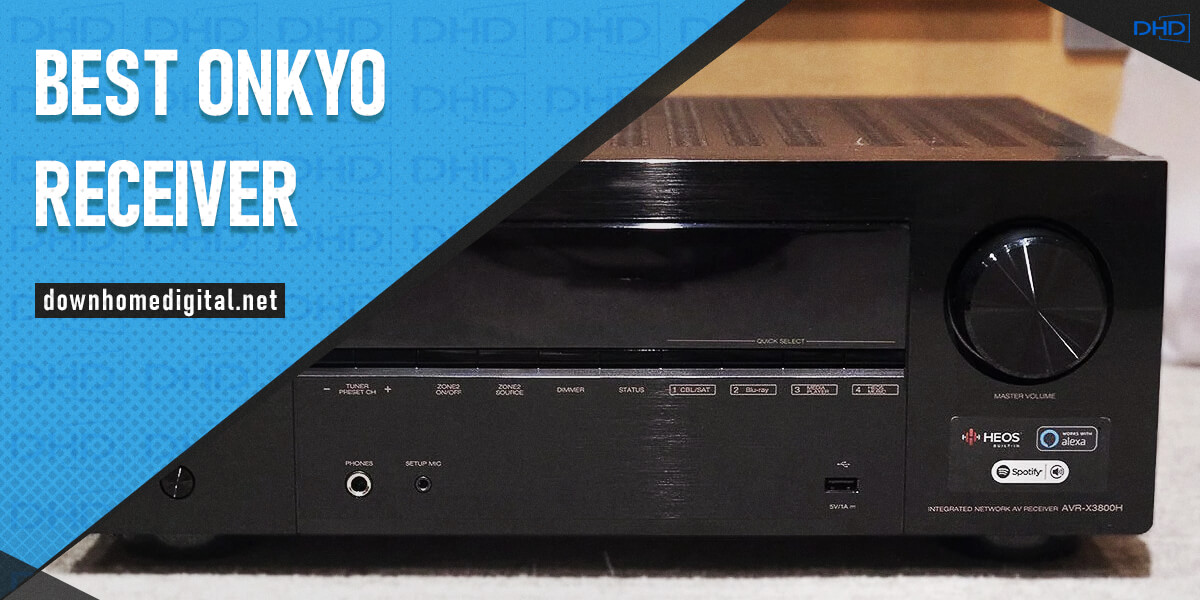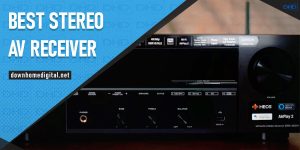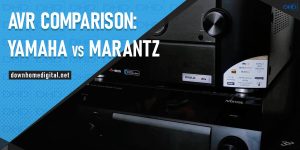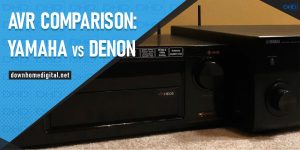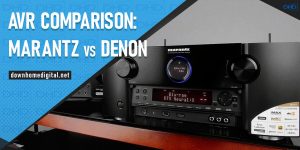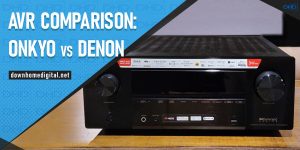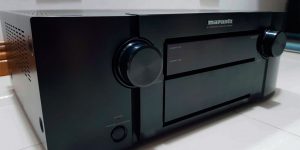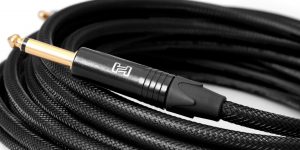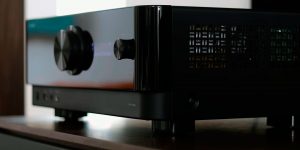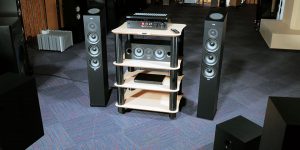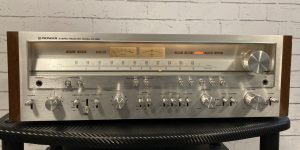For quite a long time, AV receivers have occupied the position of the leading home media center. They allow you to combine all your equipment into a single multimedia system and get the most out of sound and video. There are many companies in the receiver market, but one of the leaders is Denon. In this review, I will cover the products of this company so you can find and choose your best Denon AV receiver.
The history of this company is over 100 years. Throughout the entire duration of its activity, the company keeps its principles the same, mainly targeting better sound and reliability. And that’s why I did a detailed top Denon receivers review in order to choose the most appropriate option.
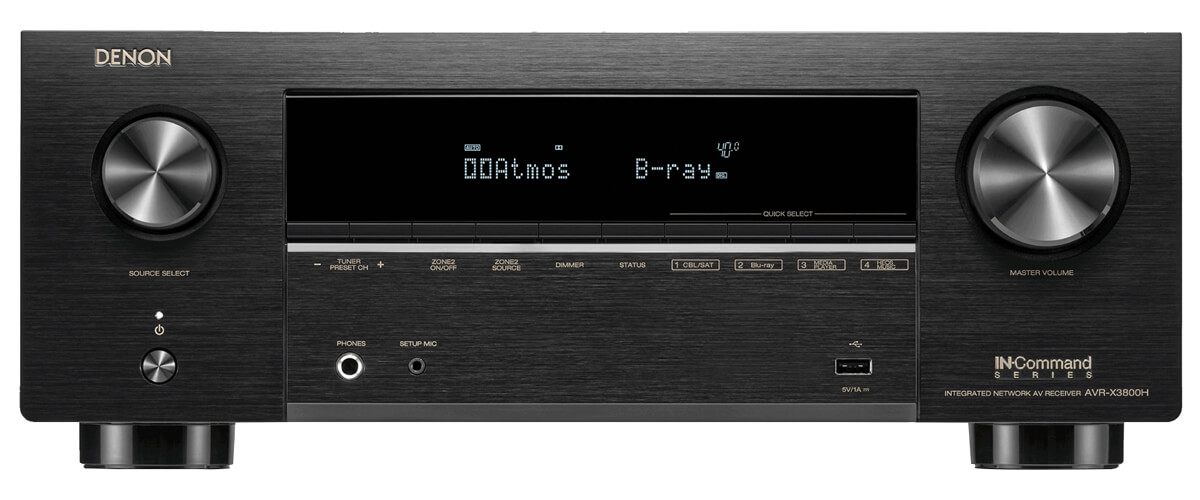
Denon receivers comparison table
| Name | Channels | Power output | HDMI in/out | Bluetooth/Wi-Fi | Review |
|---|---|---|---|---|---|
| Denon AVR-X3800H best overall | 9.4 | 105W/8 Ohm, 135W/6 Ohm | 6/3 | yes/yes | Review |
| Denon AVR-X4800H under $2000 | 9.2 | 125W/8 Ohm, 165W/6 Ohm | 8/3 | yes/yes | Review |
| Denon AVR-X2800H under $1000 | 7.2 | 95W/8 Ohm, 125W/6 Ohm | 6/2 | yes/yes | Review |
| Denon AVR-X6700H premium | 11.2 | 140W/8 Ohm, 175W/6 Ohm | 8/3 | yes/yes | Review |
| Denon AVR-X1800H budget | 7.2 | 80W/8 Ohm, 120W/6 Ohm | 6/1 | yes/yes | Review |
| Denon DRA-800H stereo | 2.0 | 100W/8 Ohm, 120W/6 Ohm | 5/1 | yes/yes | Review |
| Denon AVR-S660H entry-level | 5.2 | 75W/8 Ohm, 100W/6 Ohm | 5/1 | yes/yes | Review |
Difference between budget and premium Denon AV receivers
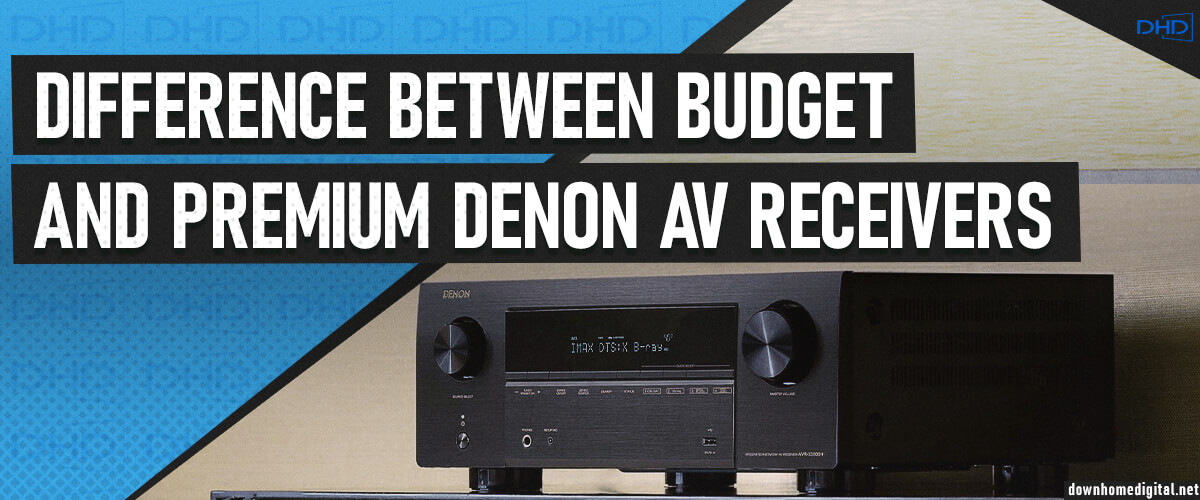
Every manufacturer of home theater receivers, and Denon is no exception, offers a wide variety of models that could find their buyer in each range of market prices, offering the best Denon receiver in its scope.
So which receiver should I choose? Budget, medium, or premium model? What is the difference between these devices? Do I need a surround sound receiver? These are the questions unsophisticated buyers have. So please read on to answer them and make an informed choice. Of course, you will not become a professional in this area, but the basic aspects will become clear to you.
I should start with corps and frame. Maybe, the first feature that people look at when buying a new device. The more costly the AVR is, the more exquisite it appears to be. And this can be seen from the plastic of the front panel and other external details of the case. More expensive receivers are also distinguished by a reinforced frame, which serves as a mount for a heavy transformer. It also dampens component vibrations.
The second item to examine, in my opinion, is connection specifications. Premium models always feature a more significant number of digital and analog interfaces. For example, a few budget models are equipped with HDMI 2.1 for 8K video streaming with HDCP 2.3 protection. The same is true for wireless protocols, the more expensive the model, the newer technologies will be used there. Also, more expensive models are equipped with more different ports, making them more versatile than budget options.
Receiver components also have a significant impact on their price. The more powerful the transformer is, the more expensive the device itself, but at the same time, we have better audio specs at the output. However, do not forget about capacitors, resistors, and DACs – all these components also increase in quality as the receiver class increases.
The most recent technology, as well as fantastic sound, are not inexpensive. Keep that in mind, and don’t search for a “great receiver for $100.”
How I picked and tested Denon receivers
The receiver`s tests require adequate preparation to appreciate the devices’ audio and visual properties. So I set up an excellent test environment.
- CD player SACD 30n
- Blu-ray player Sony UBP-X700
- Speaker wire – AudioQuest Type-9
- Speakers for movie – Klipsch RP-8060FA
- Stereo speakers:
- Klipsch RP-8060FA
- KEF Q350
- DALI OBERON 5
I decided to test devices with the “1917” movie, where there are enough talks and colorful battle scenes.
And my music list is:
- Led Zeppelin – Ramble On – Spotify
- Jacky Terrasson – Reach – Tidal
- The Weeknd – The Hills – Deezer
- Bob Marley & The Wailers – Turn Your Lights Down Low – (CD player)
- Radiohead – The National Anthem – (CD player)
- Arctic Monkeys – Do I Wanna Know – (CD player)
- Mark Nauseef – With Space in Mind (CD player)
- Mahler – Symphony No.2 (CD player)
Best Denon receiver reviews
Best mid-price Denon AVR reviews
Denon AVR-X3800H – best overall
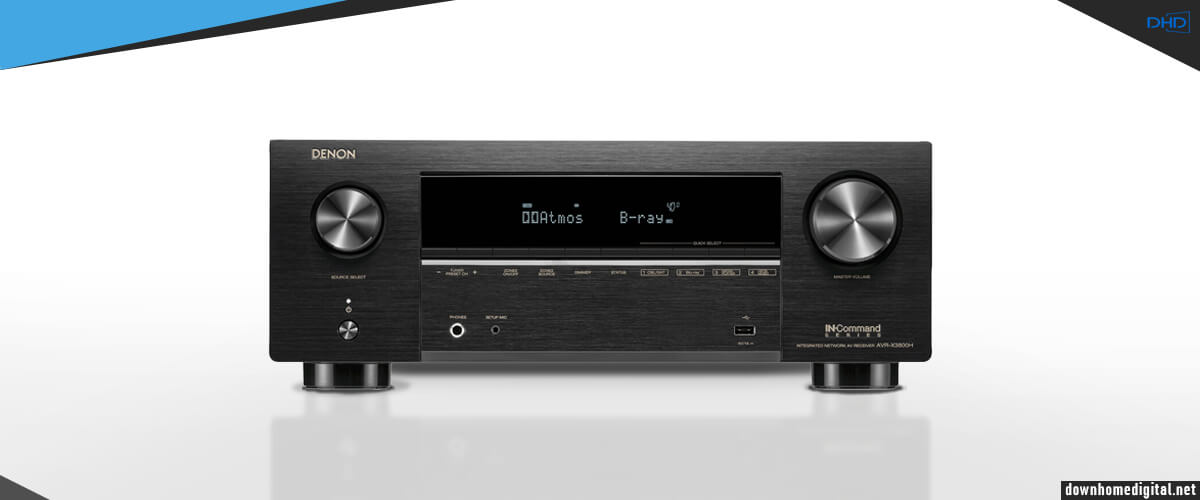
Let’s start the review by describing the AVR-X3800H, a mid-range Denon representative capable of delivering decent sound quality. This unit can handle 9.2 configurations directly (and handle up to 11.2 through external amplifiers) at 105W at an 8 Ohm load or 135W at a 6 Ohm load. That means the AVR-X3800H can be set up to operate in a Dolby Atmos 5.2.4 or 7.2.2 configuration – or add a stereo amplifier to distribute the signal to a 7.2.4-channel system. But even if you don’t have a full set of speakers with upper channels, you can still use the 3D audio supported by this receiver, namely Dolby Atmos, Dolby Atmos Virtualization Technology, DTS:X, DTS Virtual:X, IMAX Enhanced, as well as 360 Reality Audio and Auro 3D.
The receiver has an impressive weight of 33.3 pounds, which indicates quality internal components and is well-ventilated, unlike budget versions. The exterior is quite plain, but this model has a good LCD that is quite bright, and I was comfortable during testing. The controls are tight, but that’s a plus, as they are moderately sensitive, and I didn’t miss the levels and sources I was looking for. But the button control did not please me. The buttons were small and located at the bottom of the LCD, so after 10 minutes, I had my hands all over the screen. But I like the fact that I can do all the setup without the remote control, although this model has it quite well thought out, which is a rarity for the mid-price segment.
In terms of connectors, all 6 inputs and 2 outputs of the X3800H are full HDMI 2.1 connectors with support for 8K/60Hz and 4K/120Hz. In addition, all HDMI connectors support HDR10+, Dolby Vision, Dynamic HDR, and Quick Media Switching to switch resolution or frame rate to eliminate screen dimming instantly, as well as 8K upscaling and end-to-end 3D.
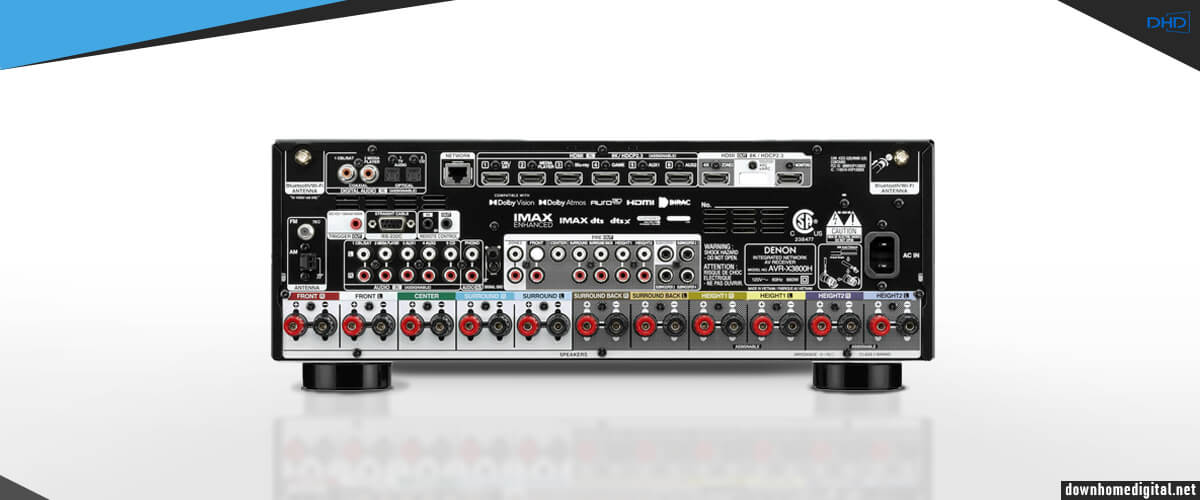
If you decide to listen to music with this 8K receiver, a useful feature of decoding Hi-Res audio files with sample rates up to 24 bits/192 kHz and DSD up to DSD128 will come in handy. Just download them over the network or via USB input. Want to listen to the analog sound? This model has a built-in MM phono stage for your turntable.
HEOS and Apple AirPlay 2 support means the opportunity for no physical interaction with the receiver. Also, in addition to connecting multi-room functions, these technologies allow the use of Amazon Alexa, Google Assistant, and Apple Siri. Streaming audio from Amazon Music and Tidal, on the other hand, did not please me as it is of low quality and stutters.
I want to recommend a pair of inexpensive front speakers for this receiver, as I was impressed with how they worked out. The ELAC Debut 2.0 F5.2 has a narrow design, so they’re a bit lacking in the bass (only if you like fat-tight lows), so I plugged in subs. With some setback from the wall (say 10 inches), I got just stunning vertical and horizontal dispersion. And I assure you, in their price segment, they simply have no equal alternatives. Anything you find better will cost you completely different money.
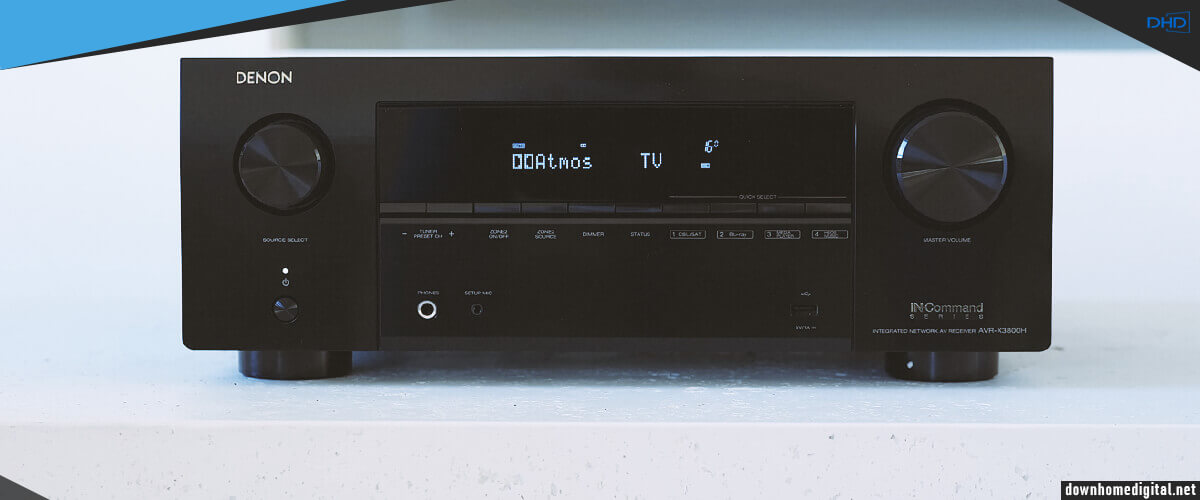
The energy and detail accuracy of this receiver is amazing. The combination of great expressive dynamics that emphasize every character phrase and make it easy to distinguish one frame from another provides an even more immersive experience on screen. I spent most of my testing in Pure Direct mode, which provides the cleanest, clearest, and most accurate signal reproduction. The sound quality was top-notch, and the Denon exceeded my expectations. Remember that first dynamic scene in the movie Morbius? When a huge number of bats fly out at Jared Leto’s character. I closed my eyes, and it felt like they surrounded me on all sides; the sound of the helicopter and the short lines sounded exactly where they should be. The only thing I lacked for total ecstasy was power. For a contender for the title of the 11-channel receiver, the AVR-X3800H pulls away from the premium Denon AVR-X6700H in just this aspect.
Denon AVR-X3800H wins in my rating as the best Denon receiver because it is the finest value for money/quality/universality. The receiver has shown itself perfectly in movie sound reproduction, for which it has decoders for almost all popular modern immersive sound formats and in stereo. So, with it, you can count on a full system for various needs, including console gaming. Practically, it is inferior to premium models only in power and number of connections, but most users who want a 9-channel system will be completely satisfied with its solid sound quality. With it, you can even build an 11-channel system in the future or distribute sound and video to 2 zones without losing channels in the main one. And you won’t have to think about upgrading for years to come. All in all, everything you could wish for at an extremely nice price. My respects to Denon.
| Power |
|
| HDMI features |
|
| Video features |
|
| Network |
|
| Surround sound processing |
|
| Channels | 9.4 |
| Stereo power (RMS), W/Ohm | 105/8, 135/6 |
| Output impedance, Ohm | 8, 6 |
| Frequency response | 10Hz-100KHz |
| THD in stereo, % | 0.08 |
| Digital to analog converter (DAC) | N/A |
| Bi-amping | yes |
| Pure direct (straight) | yes |
| Auto speaker calibration | Audyssey MultEQ XT32 |
| Speaker A/B switching | yes |
| Other audio features | Audyssey Dynamic Volume, Audyssey Dynamic EQ, Audyssey LFC, Hi-Res audio |
| Wi-Fi | 2.4/5GHz |
| USB | 1 (USB 2.0) |
| Bluetooth | yes |
| Ethernet (RJ45) | 1 |
| DLNA | yes |
| MHL | no |
| Apple Music (AirPlay) | AirPlay, AirPlay 2 |
| Amazon Music | yes |
| Spotify | yes |
| Other streaming services | Deezer, TIDAL, Pandora, SiriusXM, Qobuz, TuneIn Radio |
| HDMI input/output | 6/3 |
| HDMI ARC (Audio Return Channel) | yes |
| HDMI eARC (Enhanced Audio Return Channel) | yes |
| HDMI CEC | yes |
| Digital content protection (HDCP) | HDCP 2.3 |
| Subwoofer output (LFE) | 2 |
| Headphone output | 1 x 6.3 |
| Optical digital input | 2 |
| Coaxial digital input | 2 |
| Composite input | 3 |
| Component input/output | 2/1 |
| Phono (MM) input | yes |
| Front panel connectors | USB, phones, setup mic |
| Multi channel preamp output | yes |
| HDR (High Dynamic Range) | HDR10 |
| 4K signal pass-through | 4K/120Hz |
| 8K signal pass-through | 8K/60Hz |
| HDMI signal pass-through | yes |
| 3D signal pass-through | yes |
| HDMI pass-through in standby mode | yes |
| Video conversion | no |
| Analog to HDMI scaling | no |
| HDMI to HDMI scaling | yes |
| Dolby Vision | yes |
| Other video features | HLG, BT.2020, Dynamic HDR |
| Voice control | Amazon Alexa, Google Assistant, Siri, Josh.AI |
| App control | iPhone, iPad, iPod, Android |
| Display | colour OSD |
| Tuner | AM, FM |
| Sleep timer | yes |
| Auto power off | yes |
| ECO mode | yes |
| Graphical user interface (GUI) | yes |
| Setup assistant | yes |
| Firmware update | network, USB |
| Other additional features | IP Control, Web Control, RS-232 Control, App Control |
| Multi-room zones | 2 |
| Zone audio output | speaker, preout |
| Zone HDMI output | yes |
| Multi-room control | HEOS App, Denon 2016 AVR Remote |
| RS-232 | 1 |
| Remote control input/output (IR) | 1/1 |
| DC trigger output (12V) | 1 |
| Dolby Atmos | yes |
| Dolby TrueHD | yes |
| Dolby Surround | yes |
| Dolby (other) | Dolby Digital Plus, Dolby Atmos Height Virtualization |
| DTS:X | yes |
| DTS HD Master | yes |
| DTS Virtual:X | yes |
| DTS Neural:X | yes |
| DTS (other) | DTS-ES, DTS 96/24, DTS-HD, DTS-EXPRESS |
| Auro-3D | no |
| IMAX Enhanced | yes |
| Multichannel stereo | yes |
| MP3 | yes |
| WMA | yes |
| AAC | yes |
| WAV | yes |
| FLAC | yes |
| ALAC | yes |
| Other audio file formats | AIFF, DSD |
| Operational power consumption, W | 660 |
| Standby consumption, W | 0.1 |
| Removable power cord | yes |
| Size W x H x D, cm/inches | 43.1 x 15.2 x 35.5/17.1 x 6.6 x 14.9 |
| Weight, kg/lbs | 12.2/27.6 |
| Release year | 2020 |
Pros
- The optimal combination of quality, versatility, and affordability.
- System 9.2 can be extended to 11.4.
- Support for most modern formats of surround sound.
- There is a full set of wireless multimedia technologies.
- The image, after upscaling, looks top-notch, on par with the natural image.
- Great sounding in movies and music.
Cons
- Streaming audio from Amazon Music and Tidal is low quality and stutters.
Denon AVR-X4800H – top Denon AVR under 2000 dollars
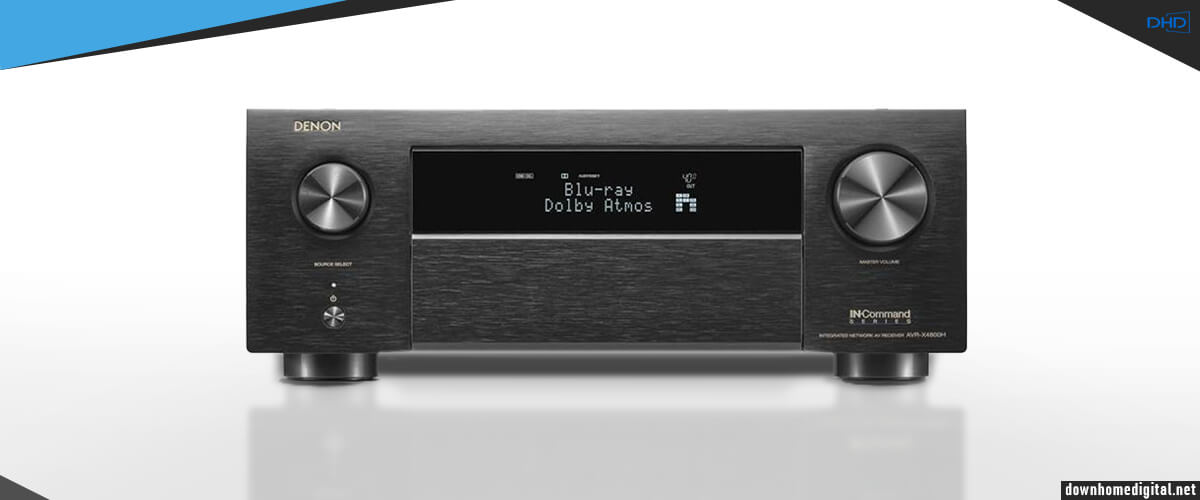
I award the title of best Denon receiver under $2000 to the Denon AVR-X4800H, as it costs a bit more than the leader of my selection but also slightly outperforms it in some features. It is a transitional link between Denon receivers in the high and mid-price range, so it does not retain the most important price/quality balance for me but is more of a premium receiver, for which it is placed on the second line of the chart.
Even externally, the receiver differs from the list leader AVR-X3800H, repeating the accents of more expensive receivers. All external controls, except for the regulators, are hidden under a securely fastened cover. And this couldn’t help but please me, as I didn’t get the LCD dirty this time. Buttons are round this time, and I was afraid they might fall off, but every press on them is a pleasure; they clearly fall into the grooves, don’t dangle, and react to light touches.
The AVR-X4800H video track is based on the latest HDMI features, such as 8K/60Hz (but only works on 1 input), 4K/120Hz with pass-through channels, and 8K upscaling. Like most similar models, it supports Dolby Vision, HDR10+, and HDCP 2.3 on all HDMI inputs. And it has 1 more HDMI input than our leader. This may not seem like a big deal to you, but I prefer an “extra” free port rather than “an even number to fit my appliances”. Who knows what fashion will dictate tomorrow and what other device we’ll want to buy? However, I have had a problem with source switching when using an 8K HDMI cable. Periodically, I saw a black screen for a few seconds. Maybe it’s not that significant, but it’s annoying.
With nine power amplifiers (125 watts into 8 ohms or 165 watts into 6 ohms), the AVR-X4800H delivers high performance with 11-channel processing and surround sound decoders for Dolby, DTS: X, and Auro-3D. Here, it outperforms the AVR-X3800H, as you can see, and that’s one of its clear advantages. The system sounds impressively powerful. However, there are worse monsters in my selection.
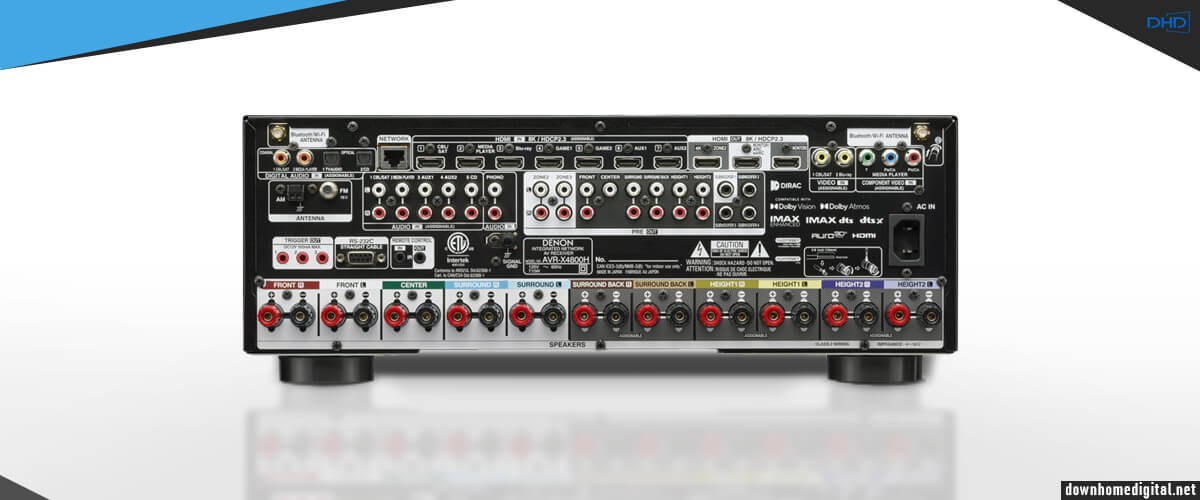
And I would like to add to what has already been said. There are decoders based on IMAX Enhanced. Of course, all the audio decoders like Dolby Surround, DTS Neural: X, and Auro-Matic are present too. This is no small factor, considering you can create a multi-room for 3 zones. You won’t lose out on sound quality even by emphasizing the channels.
When I started testing the device’s capabilities with a movie, I was immediately surrounded by a high-definition soundstage combined with spatial effects. Every action on the screen was accompanied by sound with appropriate positioning. I can’t say that overall, the AVR-X4800H sounds different from the AVR-X3800H, but the picture is certainly brighter due to more power. Under the same conditions, in the same studio, I got the effect of “glass shaking”. But warmth, brightness, and realism endure with both devices.
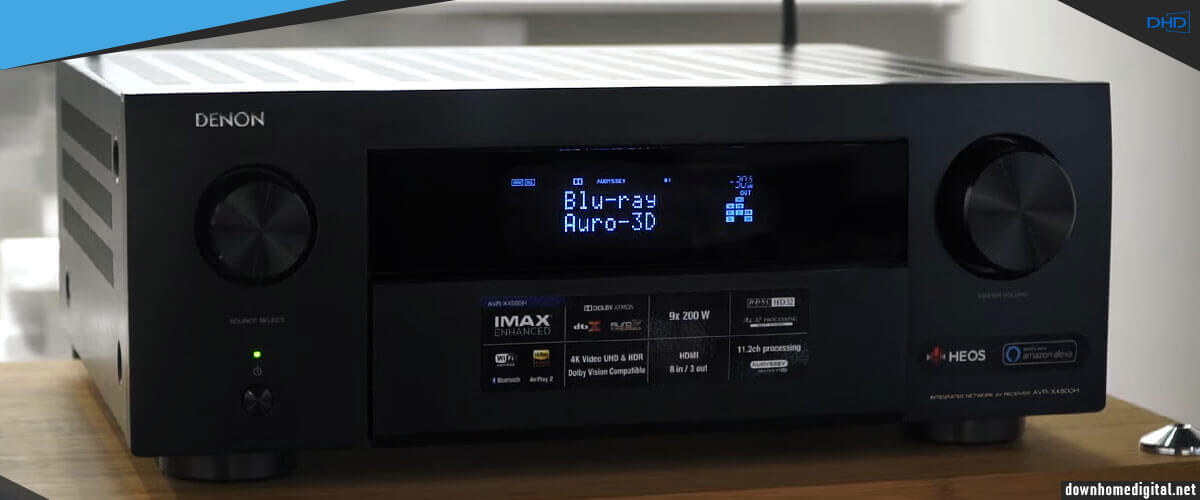
The Denon handles musical scores confidently: pulse fidelity, excellent coarse dynamics, and high spatial density provide a high perceptual quotient. The 4800H’s power is sufficient to convey detailed sound from high to low frequencies properly. It works well in my nearly 500 square-foot listening studio with no compromise, and nuance is not lost even with wired multi-room. Otherwise, you can use the HEOS protocol and do wireless multi-room or built-in streaming services to keep the unit unburdened. The quality of its performance is impressive, but that’s how it should be for a mid-priced receiver.
In the case of the model in question, I tried Klipsch RP-6000F II speakers. I won’t hide that I respect this brand, especially because they are quality stuff at a balanced price. Their development in the field of composite hybrid Tractrix horn, Tractrix ports, Cerametallic woofers, etc., is really capable of transmitting sound with a special purity. In the case of Denon, they unleash the full potential of the receiver, and you may not recognize your favorite tracks if you have never listened to them in high quality. You will discover new details and colors.
The Denon AVR-X4800H is on the borderline between premium and mid-price models but still retains a pretty nice value under $2000. You can expect a killer sound and feature set, including more power than the leader of my selection, the AVR-X3800H, with the same multichannel capabilities. Even its design suggests it’s in a higher class, though it’s still quite modest, as always with Denon. All sorts of surround sound and mixing formats, the highest resolution video, and plenty of wired and wireless connectivity. You will get all this with AVR-X4800H. But let’s be honest, the AVR-X3800H has all that, too.
In fact, your choice is limited to 3 multi-room zones, a 25W power difference, one spare HDMI, and the fact that the front panel buttons are hidden under the cover. If this is important for you, I will not dissuade you. And my choice is obvious. This receiver is in second place in my rating.
| Power |
|
| HDMI features |
|
| Video features |
|
| Network |
|
| Surround sound processing |
|
| Channels | 9.2 |
| Stereo power (RMS), W/Ohm | 125/8, 165/6 |
| Output impedance, Ohm | 8, 6 |
| Frequency response | 10Hz-100KHz |
| THD in stereo, % | 0.05 |
| Digital to analog converter (DAC) | N/A |
| Bi-amping | yes |
| Pure direct (straight) | yes |
| Auto speaker calibration | Audyssey MultEQ XT32 |
| Speaker A/B switching | yes |
| Other audio features | Audyssey Dynamic Volume, Audyssey Dynamic EQ, Audyssey LFC, Hi-Res audio |
| Wi-Fi | 2.4/5GHz |
| USB | 1 (USB 2.0) |
| Bluetooth | yes |
| Ethernet (RJ45) | 1 |
| DLNA | yes |
| MHL | no |
| Apple Music (AirPlay) | AirPlay, AirPlay 2 |
| Amazon Music | yes |
| Spotify | yes |
| Other streaming services | Deezer, TIDAL, Pandora, SiriusXM, Qobuz, TuneIn Radio |
| HDMI input/output | 8/3 |
| HDMI ARC (Audio Return Channel) | yes |
| HDMI eARC (Enhanced Audio Return Channel) | yes |
| HDMI CEC | yes |
| Digital content protection (HDCP) | HDCP 2.3 |
| Subwoofer output (LFE) | 2 |
| Headphone output | 1 x 6.3 |
| Optical digital input | 2 |
| Coaxial digital input | 2 |
| Composite input | 3 |
| Component input/output | 2/1 |
| Phono (MM) input | yes |
| Front panel connectors | USB, HDMI, phones, setup mic, AUX |
| Multi channel preamp output | yes |
| HDR (High Dynamic Range) | HDR10 |
| 4K signal pass-through | 4K/120Hz |
| 8K signal pass-through | 8K/60Hz |
| HDMI signal pass-through | yes |
| 3D signal pass-through | yes |
| HDMI pass-through in standby mode | yes |
| Video conversion | analog to HDMI |
| Analog to HDMI scaling | yes |
| HDMI to HDMI scaling | yes |
| Dolby Vision | yes |
| Other video features | HLG, BT.2020, Dynamic HDR |
| Voice control | Amazon Alexa, Google Assistant, Siri, Josh.AI |
| App control | iPhone, iPad, iPod, Android |
| Display | colour OSD |
| Tuner | AM, FM |
| Sleep timer | yes |
| Auto power off | yes |
| ECO mode | yes |
| Graphical user interface (GUI) | yes |
| Setup assistant | yes |
| Firmware update | network, USB |
| Other additional features | IP Control, Web Control, RS-232 Control, App Control |
| Multi-room zones | 3 |
| Zone audio output | speaker, preout |
| Zone HDMI output | yes |
| Multi-room control | HEOS App, Denon 2016 AVR Remote |
| RS-232 | 1 |
| Remote control input/output (IR) | 1/1 |
| DC trigger output (12V) | 2 |
| Dolby Atmos | yes |
| Dolby TrueHD | yes |
| Dolby Surround | yes |
| Dolby (other) | Dolby Digital Plus, Dolby Atmos Height Virtualization |
| DTS:X | yes |
| DTS HD Master | yes |
| DTS Virtual:X | yes |
| DTS Neural:X | yes |
| DTS (other) | DTS-ES, DTS 96/24, DTS-HD, DTS-EXPRESS |
| Auro-3D | yes |
| IMAX Enhanced | yes |
| Multichannel stereo | yes |
| MP3 | yes |
| WMA | yes |
| AAC | yes |
| WAV | yes |
| FLAC | yes |
| ALAC | yes |
| Other audio file formats | AIFF, DSD |
| Operational power consumption, W | 710 |
| Standby consumption, W | 0.1 |
| Removable power cord | yes |
| Size W x H x D, cm/inches | 43.1 x 15.2 x 35.5/17.1 x 6.6 x 14.9 |
| Weight, kg/lbs | 13.6/30.2 |
| Release year | 2020 |
Pros
- The control buttons on the body are hidden under the cover.
- More power than the leader of the AVR-X3800H selection, so you can even feel the sound.
- The overall soundscape is a little brighter than the leader, but only because of the power.
- Multiroom is for 3 zones, not 2 like the AVR-X3800H.
- There is 1 more HDMI input than ports.
- HEOS’s performance is flawless.
Cons
- Switching the source of 8K is not always smooth, and sometimes even to the complete absence of an image.
Denon AVR-X2800H – top model under $1000
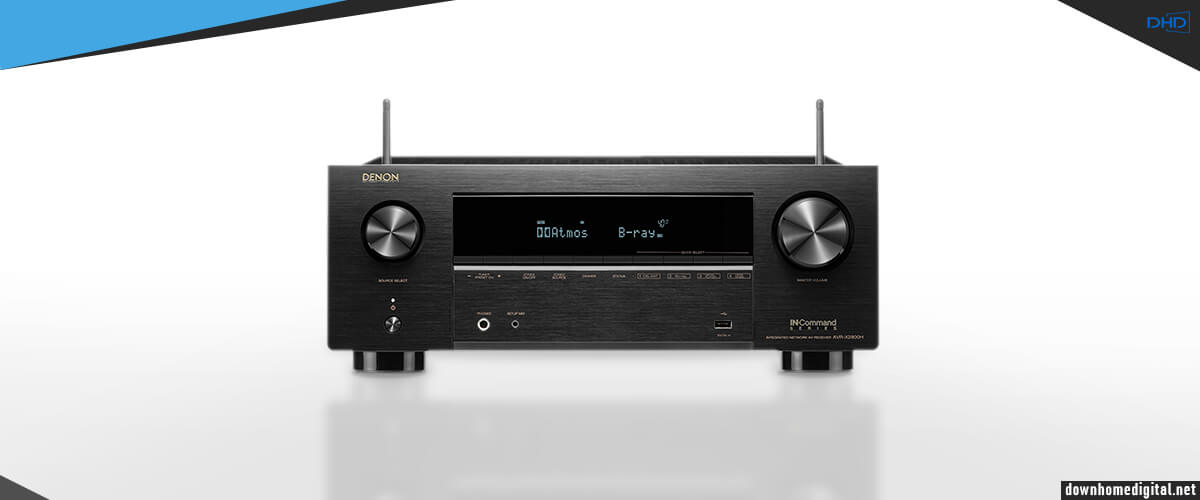
The Denon AVR-X2800H is a powerful 7.2-channel home theater media center with HEOS wireless multi-room technology. The model was released in 2022 to replace the popular X2700H and is the simplest representative of Denon’s middle class but with all the shortcomings of its predecessor taken into account. On its purchase, you will save good money without making critical compromises. And this fact especially makes it stand out against other receivers from my rating.
This receiver looks similar to AVR-X3800H, with all the same pros and cons. But I didn’t really like the remote control; it is simpler than the first place of my rating. But you can control the volume using any remote, so it’s a handy option. Of course, this model is lighter, weighing in at 25.4 lbs. All you need to understand about the effect of weight on build quality is that the lighter the weight, the less quality components inside. But this parameter is quite good for the level and price of AVR-X2800H. And I noted for myself that even under heavy loads, the receiver does not overheat.
The sound quality is really exciting thanks to the considerable power – 95 W with 8 Ohm load or 125 W with 6 Ohm load per channel. That’s almost as much as the 9-channel AVR-X3800H. And we are talking about both Hi-Fi and home theater with 3D sound. The receiver is compatible with 8K (but unlike previous receivers, only 3 of the 6 HDMI inputs are version 2.1 and pass 8K video), the most advanced surround sound formats, and their virtualized versions. Regarding connectivity (including wireless), the model has basic options, except for some additional more advanced options.
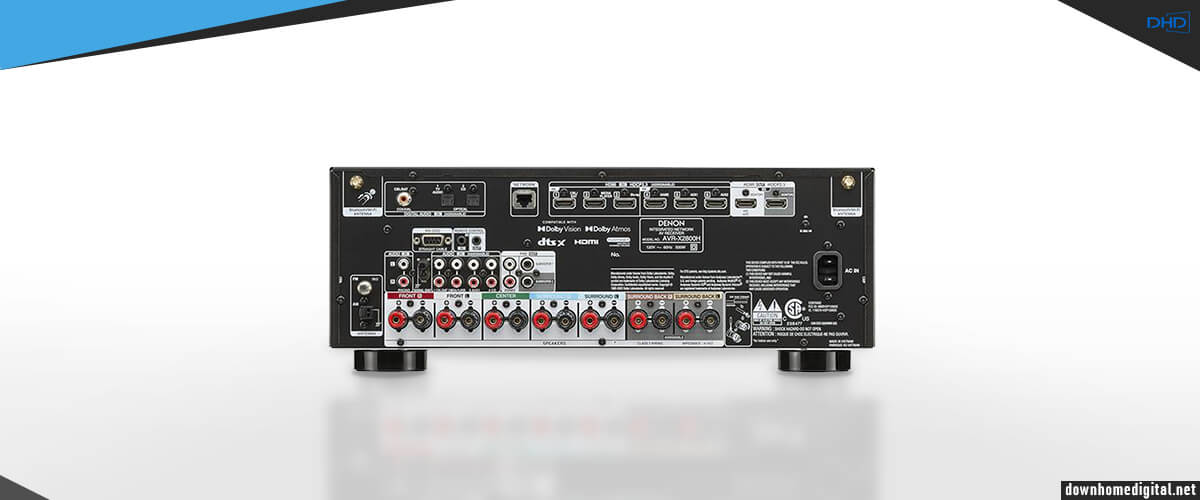
The impression made on me during testing is quite positive. It works with rich sound without unnecessary details. In the movie test, I was pleased with the high quality of the dialogue. They are reproduced with amazing clarity. All voices sound authentic, and when the dialog moves to the soundtrack’s background, the purity of sound is even more enhanced. The Denon AVR-X2800H smoothly separates the sound into different channels, not allowing other effects to drown out the dialog. It reproduces the entire frequency range – from rich bass to squeaky treble – well. However, detail is better conveyed in the middle register. But I must disappoint you, as I discovered that I am dealing with a 7.1 receiver. It just so happens that the system treats the 2 subs as a whole without recognizing them separately.
The X2800H also performed well when listening to tracks because of its advanced music features. Despite the difference between CD tracks and streaming, the Denon AVR-X2800H does a very interesting job. It creates a dense sound “scene” in the room. This applies to the multiroom capabilities as well. True, the only disadvantage of this is the control of additional zones only with the help of the receiver’s user interface.
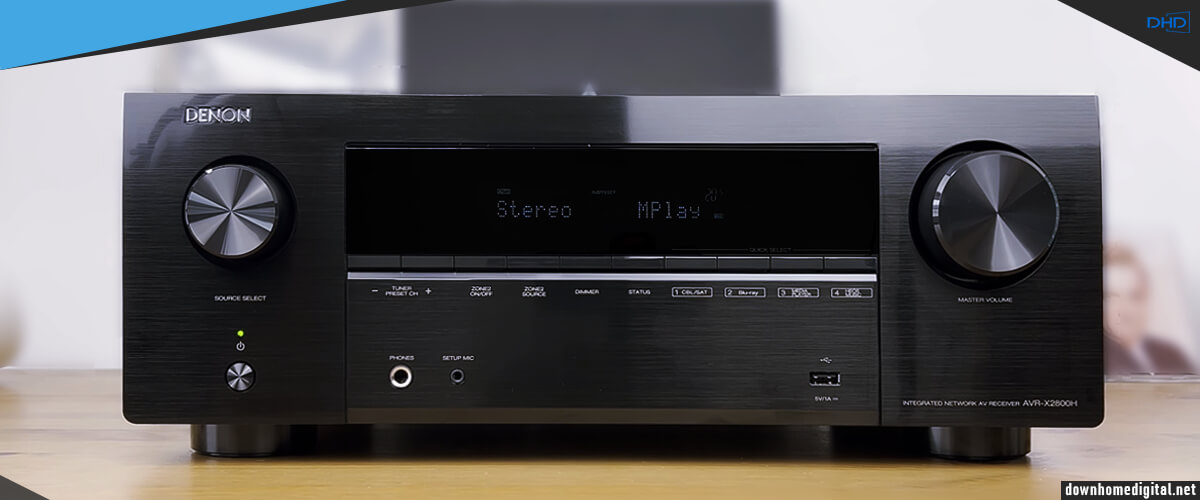
A unique feature is the possibility of simultaneous listening through speakers and headphones. It may be necessary if you have a friend or relative who is hearing impaired. But you may find other uses for it.
In my opinion, the Denon AVR-X2800H is an excellent mid-range receiver that combines good audio capabilities, as long as you are willing to be satisfied with the minimum Dolby Atmos 5.1.2 configuration. It is also equipped with a modern video section, ready for 8K resolution and upscaling to 8K, although the latter is far from the original. In fact, it has all the charms of functionality that the more expensive representatives of the category in question. Even its power is quite comparable to that of the leader AVR-X3800H.
In my review will be another 7-channel model AVR-X1800H, which will be a member of the team of budget receivers. But it is easy to assume that it is a bit inferior on all fronts. All of the above combined gives me the right to call AVR-X2800H the best Denon receiver under $1000.
| Power |
|
| HDMI features |
|
| Video features |
|
| Network |
|
| Surround sound processing |
|
| Channels | 7.2 |
| Stereo power (RMS), W/Ohm | 95/8, 125/6 |
| Output impedance, Ohm | 8, 6 |
| Frequency response | 10Hz-100KHz |
| THD in stereo, % | 0.08 |
| Digital to analog converter (DAC) | N/A |
| Bi-amping | yes |
| Pure direct (straight) | yes |
| Auto speaker calibration | Audyssey MultEQ |
| Speaker A/B switching | yes |
| Other audio features | Audyssey Dynamic Volume, Audyssey Dynamic EQ, Hi-Res audio |
| Wi-Fi | 2.4/5GHz |
| USB | 1 (USB 2.0) |
| Bluetooth | yes |
| Ethernet (RJ45) | 1 |
| DLNA | yes |
| MHL | no |
| Apple Music (AirPlay) | AirPlay, AirPlay 2 |
| Amazon Music | yes |
| Spotify | yes |
| Other streaming services | Deezer, TIDAL, Pandora, SiriusXM, Qobuz, TuneIn Radio |
| HDMI input/output | 6/2 |
| HDMI ARC (Audio Return Channel) | yes |
| HDMI eARC (Enhanced Audio Return Channel) | yes |
| HDMI CEC | yes |
| Digital content protection (HDCP) | HDCP 2.3 |
| Subwoofer output (LFE) | 2 |
| Headphone output | 1 x 6.3 |
| Optical digital input | 2 |
| Coaxial digital input | 1 |
| Composite input | 2 |
| Component input/output | 2/1 |
| Phono (MM) input | yes |
| Front panel connectors | USB, phones, setup mic |
| Multi channel preamp output | yes |
| HDR (High Dynamic Range) | HDR10 |
| 4K signal pass-through | 4K/120Hz |
| 8K signal pass-through | 8K/60Hz |
| HDMI signal pass-through | yes |
| 3D signal pass-through | yes |
| HDMI pass-through in standby mode | yes |
| Video conversion | no |
| Analog to HDMI scaling | no |
| HDMI to HDMI scaling | yes |
| Dolby Vision | yes |
| Other video features | HLG, BT.2020, Dynamic HDR |
| Voice control | Amazon Alexa, Google Assistant, Siri, Josh.AI |
| App control | iPhone, iPad, iPod, Android |
| Display | colour OSD |
| Tuner | AM, FM |
| Sleep timer | yes |
| Auto power off | yes |
| ECO mode | yes |
| Graphical user interface (GUI) | yes |
| Setup assistant | yes |
| Firmware update | network, USB |
| Other additional features | IP Control, Web Control, RS-232 Control, App Control |
| Multi-room zones | 2 |
| Zone audio output | speaker, preout |
| Zone HDMI output | no |
| Multi-room control | HEOS App, Denon 2016 AVR Remote |
| RS-232 | 1 |
| Remote control input/output (IR) | 1/1 |
| DC trigger output (12V) | 0 |
| Dolby Atmos | yes |
| Dolby TrueHD | yes |
| Dolby Surround | yes |
| Dolby (other) | Dolby Digital Plus, Dolby Atmos Height Virtualization |
| DTS:X | yes |
| DTS HD Master | yes |
| DTS Virtual:X | yes |
| DTS Neural:X | yes |
| DTS (other) | DTS-ES, DTS 96/24, DTS-HD, DTS-EXPRESS |
| Auro-3D | no |
| IMAX Enhanced | no |
| Multichannel stereo | yes |
| MP3 | yes |
| WMA | yes |
| AAC | yes |
| WAV | yes |
| FLAC | yes |
| ALAC | yes |
| Other audio file formats | AIFF, DSD |
| Operational power consumption, W | 500 |
| Standby consumption, W | 0.1 |
| Removable power cord | yes |
| Size W x H x D, cm/inches | 43.8 x 15.2 x 33/17.1 x 6.6 x 13 |
| Weight, kg/lbs | 9.5/21 |
| Release year | 2020 |
Pros
- The power is almost the same as the AVR-X3800H.
- Even under heavy loads, the receiver does not heat up.
- There is no way to control additional zones from the app.
- You can use headphones and speakers at the same time.
Cons
- Only 3 HDMI inputs are dedicated to 8K video.
- The system treats the 2 subs as a single unit, so essentially you have a 7.1 system.
- There is no way to control additional zones from the application.
Best premium Denon AV receiver reviews
Denon AVR-X6700H – best premium Denon AVR
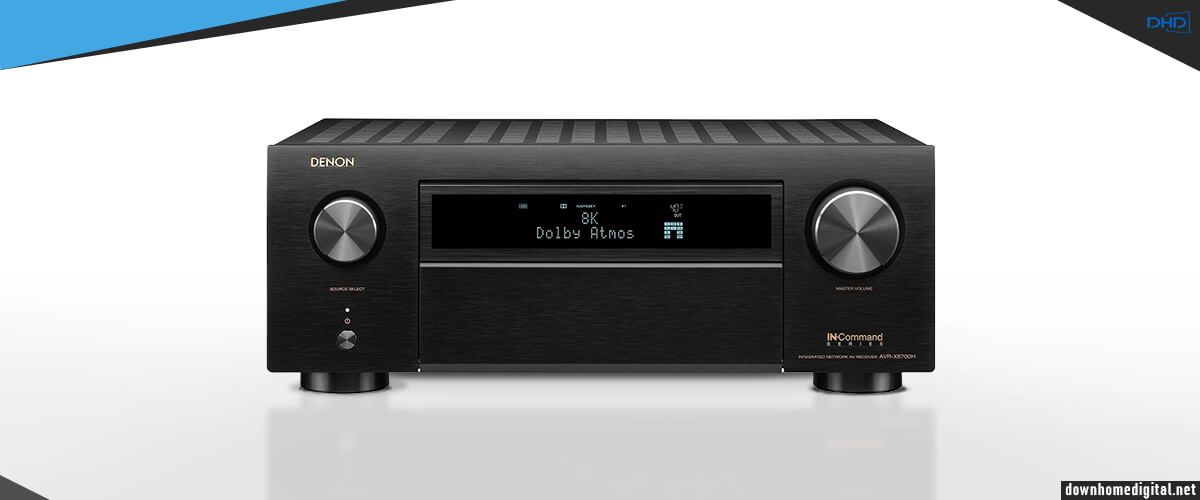
The AVR-X6700H is Denon’s top premium 8K unit. The receiver comes with an 11.2-channel amplifier module. The power is 140 W/8 Ohm or 175 W/6 Ohm per channel, and I think such an impressive power will be enough to sound even a large room fully. And if you still use two different sets of speakers, then you can create a set of settings for each of them and switch between them.
This is where my words about the receiver’s weight become more obvious. The impressive 33 pounds is a sign of the quality of both the construction and its internal components. The design is identical to the AVR-X4800H, but the number of connections is impressive. Coaxial, optical, component, gold-plated RCA, phono input – it seems that literally everything can be connected to AVR-X6700H.
When compared to the previous models, the X6700H has 8 HDMI input terminals and 3 output terminals, but only 1 input certified as HDMI 2.1 standard. That’s more than any receiver in my rating (except the next premium AVR-X8500HA). Thanks to this, the AVR-X6700H supports 8K/60Hz and 4K/120Hz, which are complemented by the latest video technologies – Dolby Vision, HDR, HDR10, and HDR10+. Needless to say, any gamer would be happy to plug their console into this Hercules. There are all the features you need to do so. Dolby Atmos, DTS: X, and even DTS: X Pro. I’d also like to draw attention to the fact that this device can work with IMAX Enhanced (up to 13 channels in 9.1.2 and 7.2.4 configurations using an external amplifier). But in addition to surround sound formats with Dolby Atmos, DTS: X, and even DTS: X Pro ceiling speakers, you also have Auro 3D, as well as a host of other mixing formats.
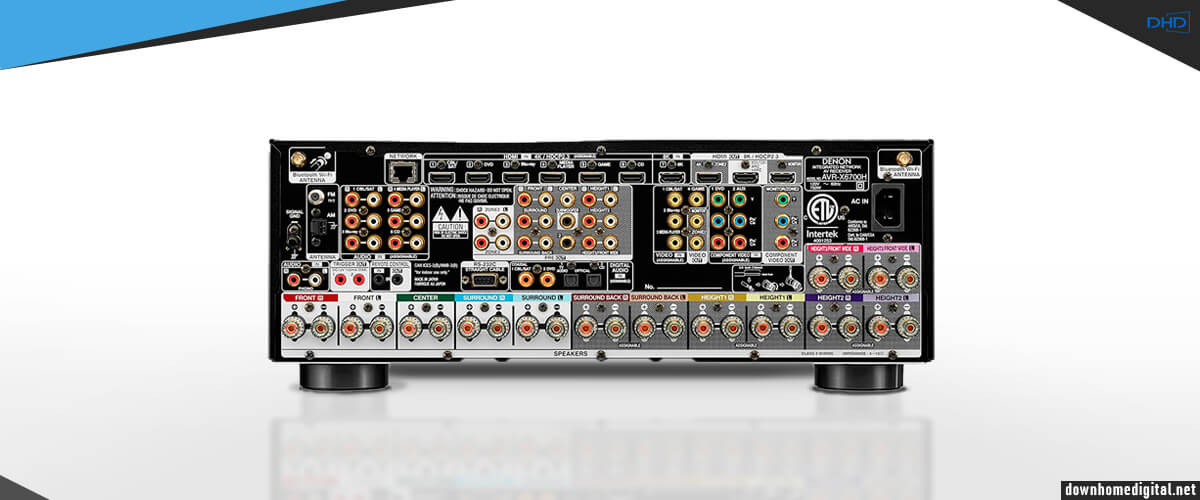
And as usual, I started the review by watching a movie. I should note that switching from Blu-ray player to TV caused unpleasant picture jerks. The testing unit produced a delightful, clean, and understandable sound, and the dynamics and detail were impeccable. However, as far as I can tell, the bass could have been a little more intense. You should realize, of course, that I am clinging to details since we are considering Denon’s premium segment. And this point I take into account without using woofers, the pure sound of the receiver. The average viewer cannot comprehend most of the points that matter to me because I use special equipment to measure dispersion, signal distribution, amplitude, etc. To put it in human terms, the receiver’s power made the hair on my head stand on end. So, with this “baby,” I recommend watching all the action movies of our time, like Mission Impossible or Agent 007.
With tracks, I got similar results. The output is accurate and detailed sound, and I had a realistic perception of the sound stage. The bass ranges were also slightly underestimated here, but the subwoofer made up for this trifle.
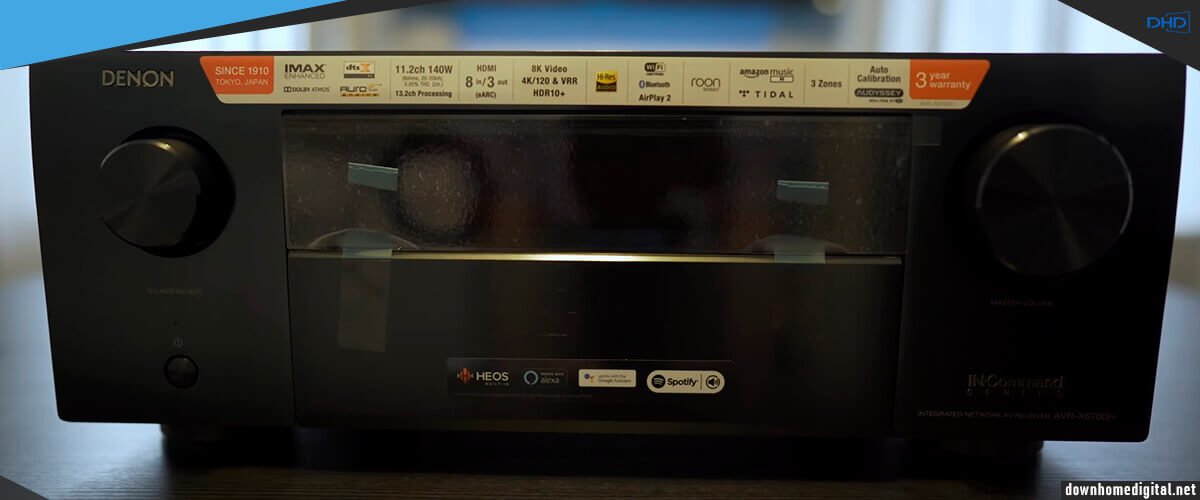
I recommend you don’t think twice this time and get a pair of KEF Q750 front speakers. They’re not the most budget-friendly, but my goodness, what the combination of this 140-watt receiver and speakers sounds like in tandem. It feels like The Rolling Stones just stood in front of me and played and sang just for me. Zero distortion. If you’re not too adept at the lower registers, you’ll get enough bass without plugging in an additional sub.
The Denon X6700H really surprised me. The latest Dolby and DTS decoders provide excellent detail, dynamics, and fidelity for a realistic surround sound experience. And when you consider that such high-quality sound accompanies an 8K picture, you can be sure that this incredible Denon AV receiver belongs to the premium class. It also owns a huge number of connections, but considering the model’s release in 2020, only 1 HDMI input has version 2.1. That’s good enough for me, as there isn’t much content in the highest resolution available today.
This behemoth will make the hair on your head move, but it’s worth adding a good subwoofer for the full experience. With some compromises but at a very nice price, it won my heart and first place in the premium Denon AV receiver category.
| Power |
|
| HDMI features |
|
| Video features |
|
| Network |
|
| Surround sound processing |
|
| Channels | 11.2 |
| Stereo power (RMS), W/Ohm | 140/8, 175/6 |
| Output impedance, Ohm | 8, 6 |
| Frequency response | 10Hz-100KHz |
| THD in stereo, % | 0.05 |
| Digital to analog converter (DAC) | N/A |
| Bi-amping | yes |
| Pure direct (straight) | yes |
| Auto speaker calibration | Audyssey MultEQ XT32 |
| Speaker A/B switching | yes |
| Other audio features | Audyssey Dynamic Volume, Audyssey Dynamic EQ, Audyssey LFC, Hi-Res audio |
| Wi-Fi | 2.4/5GHz |
| USB | 1 (USB 2.0) |
| Bluetooth | yes |
| Ethernet (RJ45) | 1 |
| DLNA | yes |
| MHL | no |
| Apple Music (AirPlay) | AirPlay, AirPlay 2 |
| Amazon Music | yes |
| Spotify | yes |
| Other streaming services | Deezer, TIDAL, Pandora, SiriusXM, Qobuz, TuneIn Radio |
| HDMI input/output | 8/3 |
| HDMI ARC (Audio Return Channel) | yes |
| HDMI eARC (Enhanced Audio Return Channel) | yes |
| HDMI CEC | yes |
| Digital content protection (HDCP) | HDCP 2.3 |
| Subwoofer output (LFE) | 2 |
| Headphone output | 1 x 6.3 |
| Optical digital input | 2 |
| Coaxial digital input | 2 |
| Composite input | 4 |
| Component input/output | 2/1 |
| Phono (MM) input | yes |
| Front panel connectors | USB, HDMI, phones, setup mic, AUX |
| Multi channel preamp output | yes |
| HDR (High Dynamic Range) | HDR10 |
| 4K signal pass-through | 4K/120Hz |
| 8K signal pass-through | 8K/60Hz |
| HDMI signal pass-through | yes |
| 3D signal pass-through | yes |
| HDMI pass-through in standby mode | yes |
| Video conversion | analog to HDMI |
| Analog to HDMI scaling | yes |
| HDMI to HDMI scaling | yes |
| Dolby Vision | yes |
| Other video features | HLG, BT.2020, Dynamic HDR |
| Voice control | Amazon Alexa, Google Assistant, Siri, Josh.AI |
| App control | iPhone, iPad, iPod, Android |
| Display | colour OSD |
| Tuner | AM, FM |
| Sleep timer | yes |
| Auto power off | yes |
| ECO mode | yes |
| Graphical user interface (GUI) | yes |
| Setup assistant | yes |
| Firmware update | network, USB |
| Other additional features | IP Control, Web Control, RS-232 Control, App Control |
| Multi-room zones | 3 |
| Zone audio output | speaker, preout |
| Zone HDMI output | yes |
| Multi-room control | HEOS App, Denon 2016 AVR Remote |
| RS-232 | 1 |
| Remote control input/output (IR) | 1/1 |
| DC trigger output (12V) | 2 |
| Dolby Atmos | yes |
| Dolby TrueHD | yes |
| Dolby Surround | yes |
| Dolby (other) | Dolby Digital Plus, Dolby Atmos Height Virtualization |
| DTS:X | yes |
| DTS HD Master | yes |
| DTS Virtual:X | yes |
| DTS Neural:X | yes |
| DTS (other) | DTS-ES, DTS 96/24, DTS-HD, DTS-EXPRESS, DTS:X Pro |
| Auro-3D | yes |
| IMAX Enhanced | yes |
| Multichannel stereo | yes |
| MP3 | yes |
| WMA | yes |
| AAC | yes |
| WAV | yes |
| FLAC | yes |
| ALAC | yes |
| Other audio file formats | AIFF, DSD |
| Operational power consumption, W | 750 |
| Standby consumption, W | 0.1 |
| Removable power cord | yes |
| Size W x H x D, cm/inches | 43.1 x 15.2 x 35.5/17.1 x 6.6 x 14.9 |
| Weight, kg/lbs | 14.5/32 |
| Release year | 2020 |
Pros
- A complete 11-channel system.
- The system can be expanded up to 13 channels (configurations 7.2.6 or 9.2.4).
- The largest number of HDMI ports in the rating (the same only in the more expensive AVR-X8500HA).
- A huge number of supported surround sound formats.
- The image is cinematic quality because of IMAX support.
- Two presets with different sound settings can be stored in the receiver’s memory.
Cons
- Only 1 HDMI input is dedicated to 8K video.
- Switching from one source to another may cause picture distortion.
- The bass power does not match the high volume of the mid and high registers.
Denon AVR-X8500HA
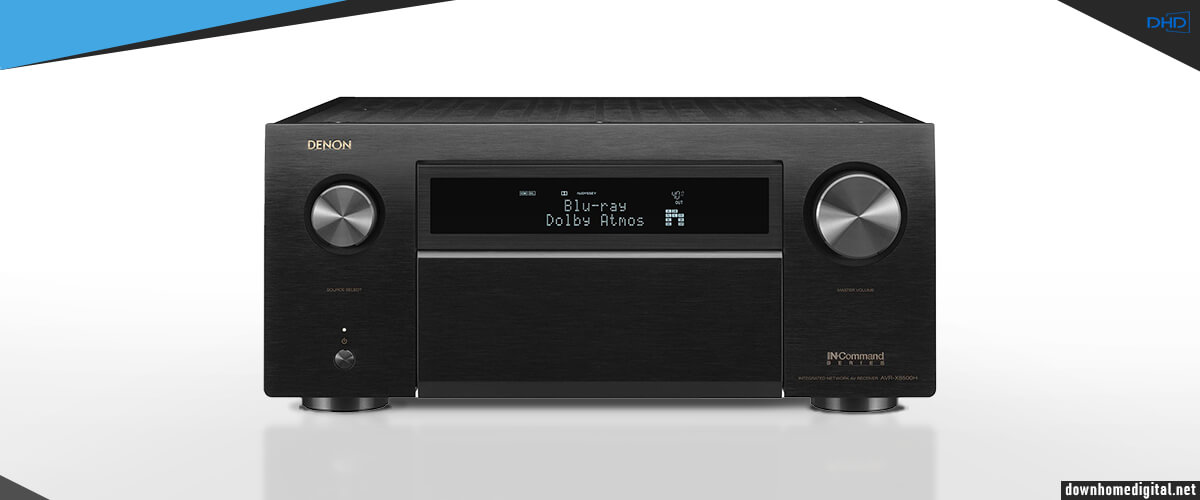
The Denon AVR-X8500HA is a particularly fantastic model thanks to its 13 power levels. This unit develops 150 watts/8 ohms or 190 watts/6 ohms per channel. In addition, it must be said that in single-channel functionality mode, the unit delivers an impressive 260 watts at 6 ohms impedance. That said, squeeze it to the max – you won’t hear any perceptible interference. It can be used with major immersive audio standards such as Dolby Atmos, DTS: X, Auro-3D, etc. With the latter, you can configure a 7.1.6 or 9.1.4 surround sound speaker set by adding a maximum of six additional speakers in height. It sounds like a movie theater set up just for you alone (well, or your family or company).
I’ve called the participants in my selection “Monster” and “Hercules”, and now I don’t know how to single out the Denon AVR-X8500HA. Colossus of Rhodes? Quite fitting, as it’s quite the marvel. The huge dimensions of 17.1 x 19 x 7.7 and the incredible weight of 52 pounds told me all I needed to know before I even touched the receiver. It reminded me of the old days when old-generation receivers weighed so much that you had to carry them by two. But there it was more hardware; here, it was a processor and chips of the highest level. By and large, there is nothing to say about the appearance. But if you have a chance – just touch it, twist the knobs (I know I remind you of a fetishist, no need to laugh, I’m just a little in love with “my beauty”). Even the remote control of Denon AVR-X8500HA is of a different generation; it has its own little LCD!
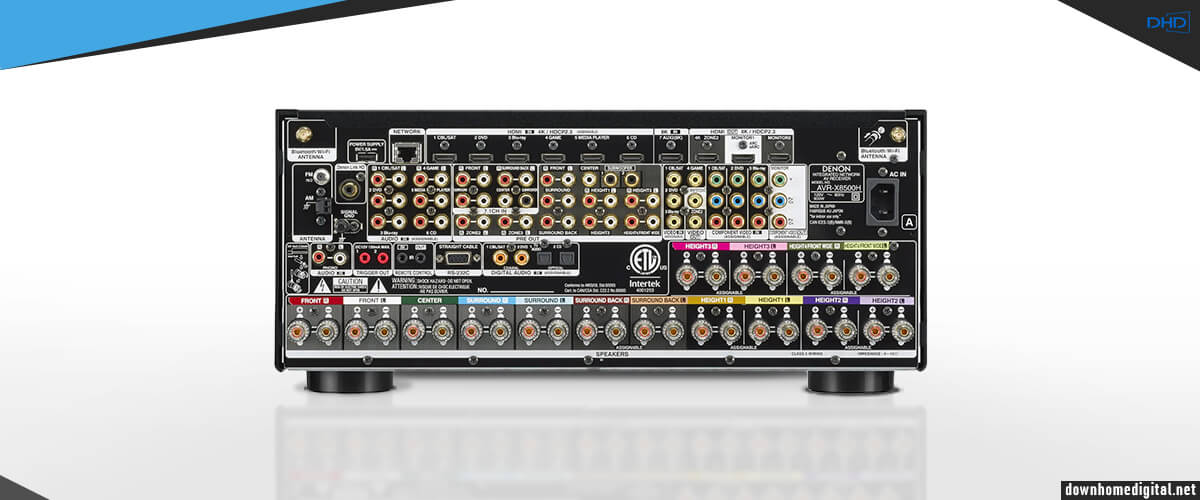
There is no point in describing my impressions of the receiver’s sound. I’m sure that at its price, it’s clear to you that it sounds fantastic, incredible, amazing, and, of course, no one else in this review can match it. You don’t even need sound wave instruments, just a huge room for the system to reach its full potential. You will only be able to connect 2 woofers, but more is here and not a necessity. I heard detailed, bright, and spacious sounds during the movie test. The sound of the battle scenes was so realistic that I practically became a participant in what was happening. I experienced a real immersive effect. While listening to the music, I also got results. I clearly separated instruments and vocals worthy of the highest praise. The frequencies from high to low sounded good and clear. I was surrounded by soft and mesmerizing music. I can summarize that Denon also did an excellent job with the music.
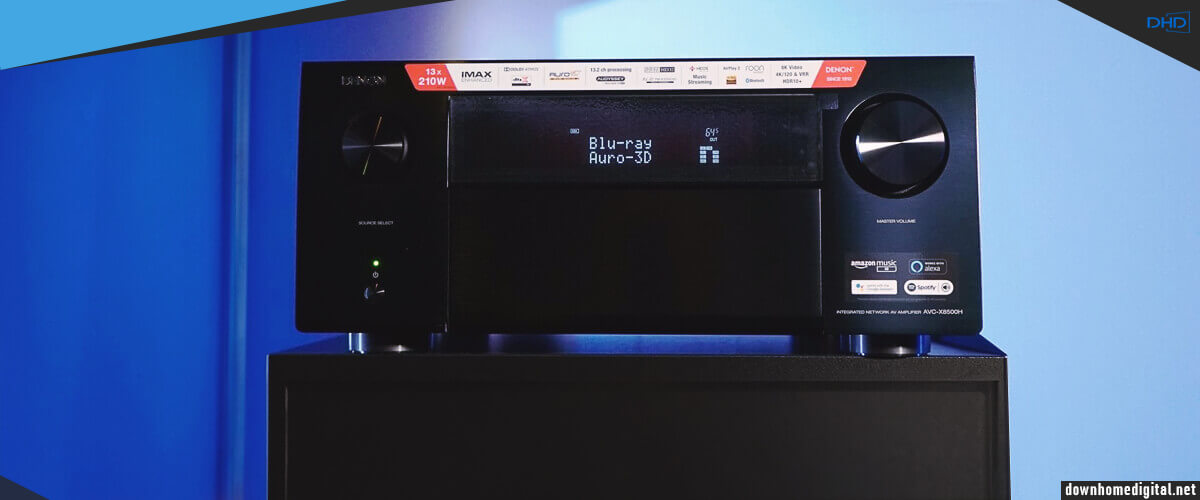
I don’t have enough space to describe the benefits of AVR-X8500HA. I will just say that you will get almost everything in the AVR field today. There are so many HDMI inputs that you’ll never run out of them. But it is worth explaining that if you look at the features of all Denon receivers, you will not notice a huge difference in specifications (except for power, number of channels, number of connectors, and some additional “bells”); you need to understand that you pay an increased price for the quality of components, and as a result – the quality of the transmission of video and audio signals. Accordingly, as a result, you can see a noticeable difference in the result of the sound and video picture. For example, thanks to HDMI connectivity and HDCP 2.2 protection, which every model described in this review has, I got the most out of the available 4K source. In addition, I’ll mention support for HDR10+, Dolby Vision, and HLG, which provides the highest image quality not only from modern digital video sources but also from older analog sources. You might not notice the difference unless you are an advanced user. That’s why this second most expensive receiver from the whole Denon lineup is suitable only for those who appreciate the highest quality and are ready to pay decent money.
Denon AVR-X8500HA is equipped with 13 amplifiers that develop the power of 150 W per channel, each of which has a 32-bit audio converter; can fully respond to configurations Dolby Atmos and DTS X in 9.2.4; supports almost all the most advanced formats of surround sound and video, and that’s why it costs so much. Of course, in terms of sound level and signal processing quality, no one else in the selection can match it. However, few people will be able to afford this truly premium receiver, and that’s why it is in second place in its category. Nevertheless, the high price is the only obvious disadvantage of the AVR-X8500HA. But if I were to compare the models in my rating with cars, I would say that by buying this model, you become the owner of a Maserati.
| Power |
|
| HDMI features |
|
| Video features |
|
| Network |
|
| Surround sound processing |
|
| Channels | 13.2 |
| Stereo power (RMS), W/Ohm | 150/8, 250/6 |
| Output impedance, Ohm | 8, 6 |
| Frequency response | 10Hz-100KHz |
| THD in stereo, % | 0.05 |
| Digital to analog converter (DAC) | AK4490EQ 768 KHz/32-bit |
| Bi-amping | yes |
| Pure direct (straight) | yes |
| Auto speaker calibration | Audyssey MultEQ XT32 |
| Speaker A/B switching | yes |
| Other audio features | Audyssey Dynamic Volume, Audyssey Dynamic EQ, Audyssey LFC |
| Wi-Fi | yes |
| USB | 1 (USB 2.0) |
| Bluetooth | yes |
| Ethernet (RJ45) | 1 |
| DLNA | yes |
| MHL | no |
| Apple Music (AirPlay) | AirPlay, AirPlay 2 |
| Amazon Music | yes |
| Spotify | yes |
| Other streaming services | Deezer, TIDAL, Pandora, Napster, SiriusXM, TuneIn Radio, iHeart Radio, Sound Cloud |
| HDMI input/output | 8/3 |
| HDMI ARC (Audio Return Channel) | yes |
| HDMI eARC (Enhanced Audio Return Channel) | yes |
| HDMI CEC | yes |
| Digital content protection (HDCP) | HDCP 2.2 |
| Subwoofer output (LFE) | 2 |
| Headphone output | 1 x 6.3 |
| Optical digital input | 2 |
| Coaxial digital input | 2 |
| Composite input | 4 |
| Component input/output | 3/1 |
| Phono (MM) input | yes |
| Front panel connectors | USB, HDMI, phones, setup mic |
| Multi channel preamp output | yes |
| HDR (High Dynamic Range) | yes |
| 4K signal pass-through | 4K/60Hz |
| 8K signal pass-through | no |
| HDMI signal pass-through | yes |
| 3D signal pass-through | yes |
| HDMI pass-through in standby mode | yes |
| Video conversion | analog to HDMI |
| Analog to HDMI scaling | yes |
| HDMI to HDMI scaling | yes |
| Dolby Vision | yes |
| Other video features | HLG, BT.2020 |
| Voice control | Amazon Alexa, Google Assistant, Siri, Josh.AI |
| App control | iPhone, iPad, iPod, Android, Amazon Kindle |
| Display | colour OSD |
| Tuner | AM, FM |
| Sleep timer | yes |
| Auto power off | yes |
| ECO mode | yes |
| Graphical user interface (GUI) | yes |
| Setup assistant | yes |
| Firmware update | network, USB |
| Other additional features | IP Control, Web Control |
| Multi-room zones | 3 |
| Zone audio output | speaker, preout |
| Zone HDMI output | yes |
| Multi-room control | HEOS App |
| RS-232 | 1 |
| Remote control input/output (IR) | 1/1 |
| DC trigger output (12V) | 2 |
| Dolby Atmos | yes |
| Dolby TrueHD | yes |
| Dolby Surround | yes |
| Dolby (other) | Dolby Digital Plus |
| DTS:X | yes |
| DTS HD Master | yes |
| DTS Virtual:X | no |
| DTS Neural:X | yes |
| DTS (other) | DTS-ES, DTS 96/24, DTS-HD, DTS-EXPRESS, DTS-Surround |
| Auro-3D | yes |
| IMAX Enhanced | yes |
| Multichannel stereo | yes |
| MP3 | yes |
| WMA | yes |
| AAC | yes |
| WAV | yes |
| FLAC | yes |
| ALAC | yes |
| Other audio file formats | has not |
| Operational power consumption, W | 900 |
| Standby consumption, W | 0.1 |
| Removable power cord | yes |
| Size W x H x D, cm/inches | 43.5 x 19.5 x 7.8/17 x 7.7 x 18.7 |
| Weight, kg/lbs | 23.1/51.6 |
| Release year | 2018 |
Pros
- A complete system with 13 channels of amplification.
- The construction is heavy (52 pounds), indicating top quality, and the remote has its own LCD.
- It has a 32-bit audio converter for each channel.
- Combines today’s most advanced features and built-in functions.
- There are so many HDMI inputs that you will never run out of them.
Cons
- Only 2 subs can be connected, unlike the AVR-X3800H’s 4.
- I found no obvious flaws during my testing.
Best budget Denon receiver reviews
Denon AVR-X1800H – best budget Denon receiver

Well, if you have an extremely limited budget or just want to get acquainted with the world of surround sound, there is an option for you in my inexpensive models. And the first place in this category goes to Denon AVR-X1800H – an affordable classic 7.2 receiver with surround sound capability. It has all the basic functions and connections and has enough power (80W at 8 ohms or 120W at 6 ohms) to meet modern standards. In addition, the powerful amplifier unit provides another function not available to some budget receivers – bi-amping. And the receiver can also work with a vinyl player. In general, it’s quite a versatile AVR.
Here is a vivid example of how the quality of a receiver can be determined by its weight. This simpleton is only 19 pounds, and it suffers from the standard problem of budget receivers – overheating during prolonged operation. I usually solve this problem by placing additional external (and sometimes internal) fans. The main thing is to try to keep an eye on your equipment and check it sometimes; it is nice and it will be grateful to you for serving a little longer. Externally, everything is as usual in the inexpensive Denon line. But even to the touch, the receiver is simpler, not as solid as even Denon AVR-X2800H, which it looks like.
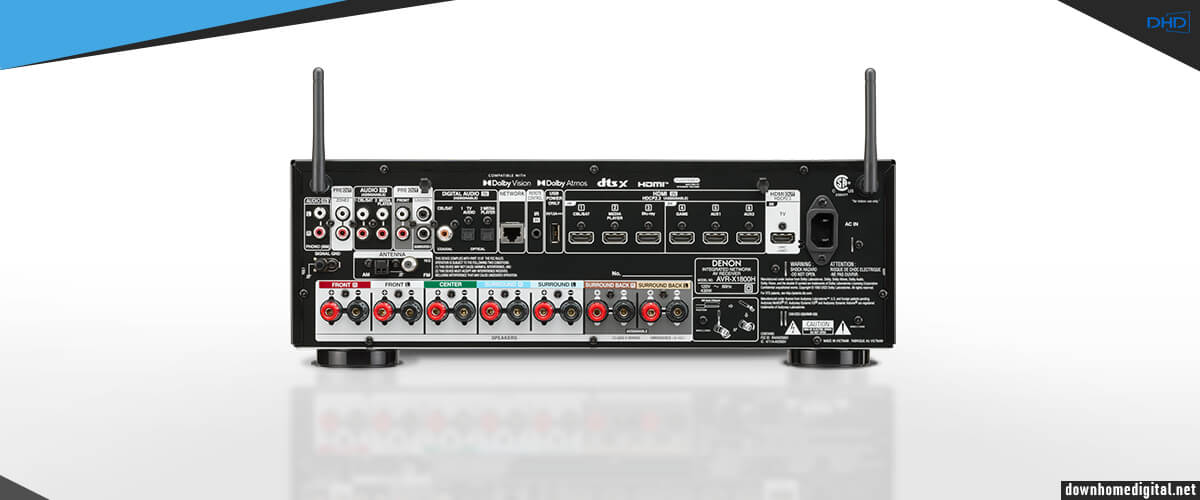
Let’s start with video capabilities. On the specifications panel of Denon AVR-X1800H, there are 6 HDMI ports, 3 of which have version 2.1 and support 8K video resolution, and only 1 output, but with eARC support. All HDMI inputs accept 4K/120Hz, HDCP 2.2, HDR10, Dolby Vision, and HLG. And thanks to this kit, I had no problems with compatibility with UHD TVs and Blu-ray players, which already support higher resolutions than classic Full HD. This is a big step up from the Denon AVR-X1600H that this model replaced.
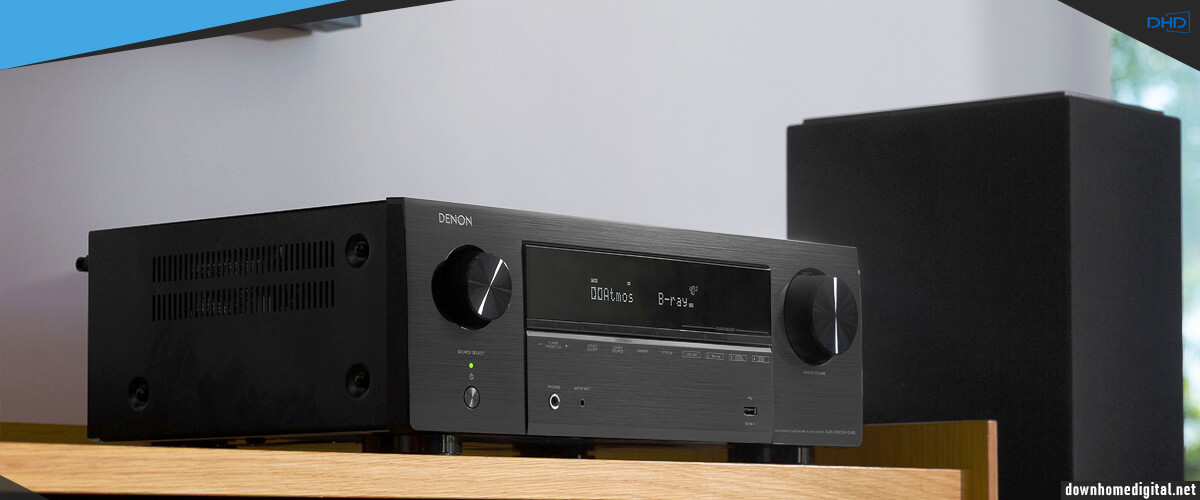
As for music, the functionality is excellent – listening to Hi-Fi on the Denon AVR-X1800H and listening to streaming music works very well. However, as soon as I increased the volume above average, distortions appeared, and detail was lost, a characteristic feature of budget models. The sound is quite clear but less loaded with low frequencies. The vocal parts sound clear, and the treble of strings sounds very natural. All of this gave the impression of a rich soundstage around me. But all this is within the capabilities of similar cheap receivers.
I tried it out in surround sound, and it pleasantly pleased me with Denon standards. The sound is realistic, rich in detail, bright and multi-layered. In general, within the requirements for modern budget-class receivers – it is very decent. Most importantly, with it, you will learn the delights of Dolby Atmos and DTS:X, though in the minimum configuration. Virtual 3D sound formats such as Dolby Atmos Height Virtualization and DTS Virtual:X will save you from the need to drill ceilings for speakers. I was quite satisfied with the sound simulation (and I made sure that the claimed features matched the truth). And there’s a Dolby Atmos Music mode, so if you’re into special content, you can listen to surround music.
The Denon AVR-X1700H should be considered Denon’s best budget AVR, with a comprehensive list of features and fairly outstanding performance for its cost. The fact that it allows Dolby Atmos, Dolby Atmos pitch virtualization technology, DTS:X and DTS Virtual:X, and 8K video proves that buying such a great option makes sense and will keep you happy for years, especially if you treat it with the proper care. The device sounds decent, much better than representatives of other brands at an identical price, but this is not surprising. The receiver was released in 2023, and such a popular and famous brand simply has to meet modern requirements, standards, and wide competition. Of course, the construction and sound quality are not comparable to more expensive models but will satisfy the unsophisticated viewer.
| Power |
|
| HDMI features |
|
| Video features |
|
| Network |
|
| Surround sound processing |
|
| Channels | 7.2 |
| Stereo power (RMS), W/Ohm | 80/8, 120/6 |
| Output impedance, Ohm | 8, 6 |
| Frequency response | 10Hz-100KHz |
| THD in stereo, % | 0.08 |
| Digital to analog converter (DAC) | 384 KHz/32-bit |
| Bi-amping | yes |
| Pure direct (straight) | yes |
| Auto speaker calibration | Audyssey MultEQ XT |
| Speaker A/B switching | yes |
| Other audio features | Audyssey Dynamic Volume, Audyssey Dynamic EQ, Compressed Audio Restorer |
| Wi-Fi | yes |
| USB | 1 (USB 2.0) |
| Bluetooth | yes |
| Ethernet (RJ45) | 1 |
| DLNA | no |
| MHL | no |
| Apple Music (AirPlay) | AirPlay, AirPlay 2 |
| Amazon Music | yes |
| Spotify | yes |
| Other streaming services | Deezer, TIDAL, Pandora, Napster, TuneIn Radio, iHeart Radio, Mood Mix |
| HDMI input/output | 6/1 |
| HDMI ARC (Audio Return Channel) | yes |
| HDMI eARC (Enhanced Audio Return Channel) | yes |
| HDMI CEC | yes |
| Digital content protection (HDCP) | HDCP 2.3 |
| Subwoofer output (LFE) | 2 |
| Headphone output | 1 x 6.3 |
| Optical digital input | 2 |
| Coaxial digital input | 1 |
| Composite input | 2 |
| Component input/output | 0/0 |
| Phono (MM) input | yes |
| Front panel connectors | USB, HDMI, phones, setup mic |
| Multi channel preamp output | no |
| HDR (High Dynamic Range) | HDR10 |
| 4K signal pass-through | 4K/60Hz |
| 8K signal pass-through | no |
| HDMI signal pass-through | yes |
| 3D signal pass-through | yes |
| HDMI pass-through in standby mode | yes |
| Video conversion | no |
| Analog to HDMI scaling | no |
| HDMI to HDMI scaling | no |
| Dolby Vision | no |
| Other video features | HLG, BT.2020 |
| Voice control | Amazon Alexa, Google Assistant, Siri, Josh.AI |
| App control | iPhone, iPad, iPod, Android, Amazon Kindle |
| Display | colour OSD |
| Tuner | AM, FM |
| Sleep timer | yes |
| Auto power off | yes |
| ECO mode | yes |
| Graphical user interface (GUI) | yes |
| Setup assistant | yes |
| Firmware update | network, USB |
| Other additional features | IP Control, Web Control |
| Multi-room zones | 2 |
| Zone audio output | speaker, preout |
| Zone HDMI output | no |
| Multi-room control | HEOS App |
| RS-232 | 0 |
| Remote control input/output (IR) | 0/0 |
| DC trigger output (12V) | 0 |
| Dolby Atmos | yes |
| Dolby TrueHD | yes |
| Dolby Surround | no |
| Dolby (other) | Dolby Digital Plus, Dolby Atmos Height Virtualization |
| DTS:X | yes |
| DTS HD Master | yes |
| DTS Virtual:X | yes |
| DTS Neural:X | yes |
| DTS (other) | DTS-ES, DTS 96/24, DTS-HD, DTS-EXPRESS |
| Auro-3D | no |
| IMAX Enhanced | no |
| Multichannel stereo | yes |
| MP3 | yes |
| WMA | yes |
| AAC | yes |
| WAV | yes |
| FLAC | yes |
| ALAC | yes |
| Other audio file formats | AIFF |
| Operational power consumption, W | 430 |
| Standby consumption, W | 0.1 |
| Removable power cord | yes |
| Size W x H x D, cm/inches | 43.5 x 15.2 x 33/17 x 6 x 13.3 |
| Weight, kg/lbs | 8.6/19 |
| Release year | 2019 |
Pros
- There is a possibility of bi-amping.
- Some HDMI ports support 8K.
Cons
- Lightweight, non-solid construction.
- Heats up during prolonged operation.
- A limited number of connections compared to other models in the rating.
- Distortions at high volume.
Denon DRA-800H – good stereo receiver
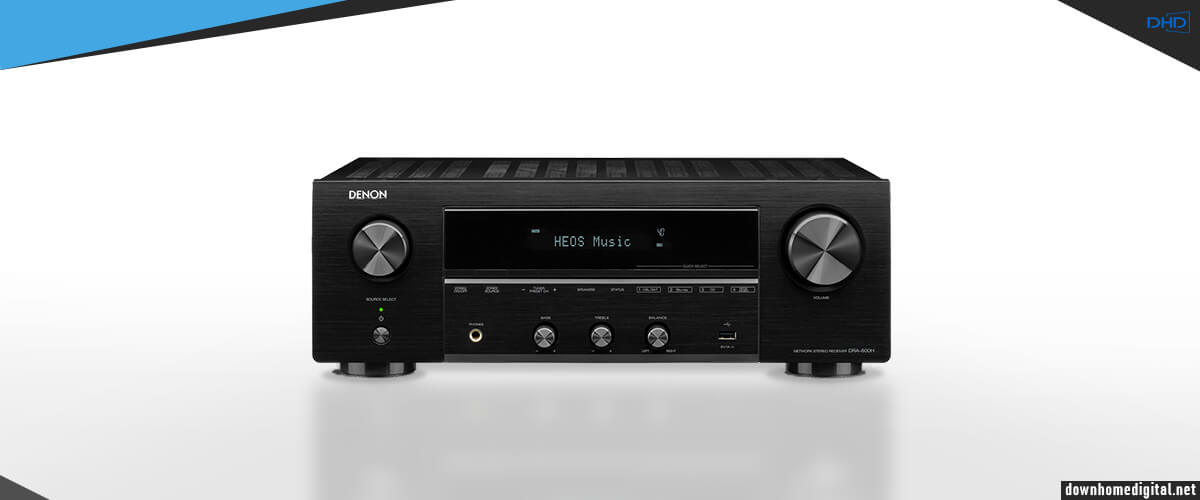
Denon DRA-800H is specially designed for stereo music lovers. And with FM and DAB + radio tuners, dedicated headphone terminals, Wi-Fi, and multiple digital inputs, including HDMI, I got excellent stereo sound with preamp support and home cinema functionality.
The classic appearance with those nightmarish little buttons right under the LCD is, this time, supplemented with small round controls for frequency control. And this, for me, is a good indicator of the manufacturer’s care. Still, we are talking about a stereo amplifier with no auto-calibrations, and tuning depends only on the user. The small, lightweight 18.3 lbs. unit doesn’t take up much space and gives a pleasant feeling of owning a decent level of equipment. It doesn’t look like a professional amplifier. In fact, it’s a next-generation hybrid altogether, designed not only for music but also quite capable of enhancing your movie-watching experience. It has special connectors for this purpose.
The DRA-800H offers five HDMI inputs and one HDMI output supporting 60Hz Full 4K Ultra HD video resolution with support for all the latest video technologies. There is also HDMI ARC, which ensures smooth sound transmission directly from the Smart TV to the receiver via a single HDMI cable.

I can note that this model develops the power declared by the Denon company – 100 W/8 Ohm or 120 W/6 Ohm per channel using proprietary audiophile-grade resistors and capacitors. It also uses AKM AK4458 DACs. And I checked it out and can say that DRA-800H decodes HD signals from a wide range of lossless file formats, including ALAC, FLAC, and WAV, up to 24-bit / 192 kHz.
I started my Denon DRA-800H test by playing a movie on a 4K TV. Only the receiver had to be set up manually. Despite the stereo configuration, the sound was smooth, low frequencies pushed, and the sound stage was excellent and comprehensive. Dialogues were quite naturally separated from the specificationsground.
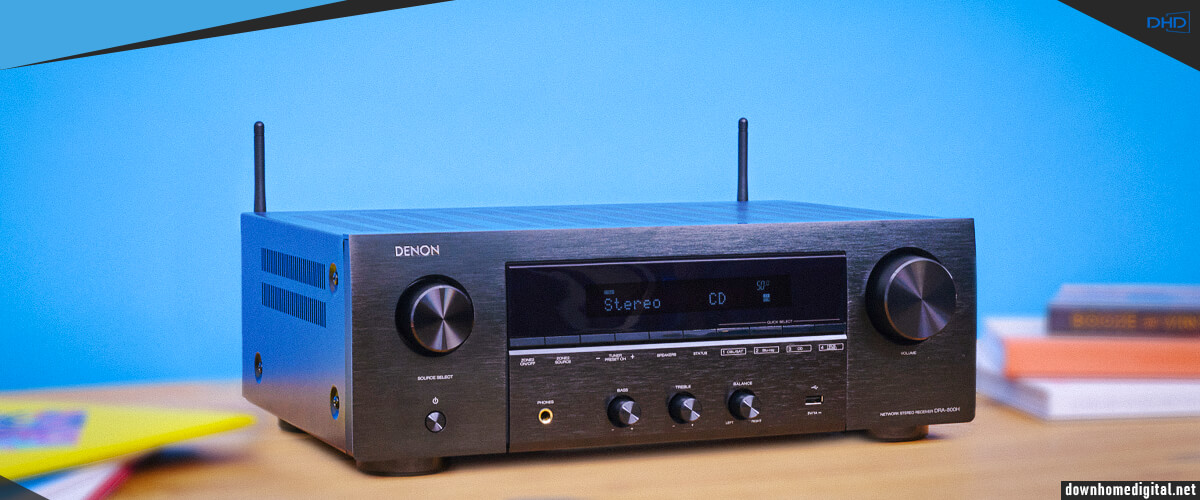
When listening to Hi-Fi music, I was quite impressed with the naturalness of the sound. The soundstage was quite wide, and instruments sounded “authentic”. When listening to wireless audio from streaming services, I wasn’t disappointed either, despite the compression of the audio stream. You can also connect a vinyl player, as the receiver has a preamplifier and a grounded phono input. I tried it, and the sound is very pleasant, although it is far from an audiophile.
The sound sometimes lacked clarity and nuance, but it was still relatively smooth and pleasant. The Denon receiver doesn’t seem to emphasize compression defects.
The combination of features for watching modern content and listening to music with enhanced quality gives me the right to safely call the Model 2019 DRA-800H the best stereo Denon receiver. Quality components and focus on the modern user – that’s the goal the brand always adheres to. Yes, it’s not the cheapest stereo receiver on the market, but with cheaper models offering around 50W of power, it’s worth its money. And considering that the model was released in 2019, you should trust the opinion of users who have left high praise for this product.
You should not compare the DRA-800H with professional amplifiers. It does not claim such a title, representing an inexpensive, easy-to-operate device that will improve your experience of watching movies and listening to music. This is its main task, which it fulfills to the fullest.
| Power |
|
| HDMI features |
|
| Video features |
|
| Network |
|
| Surround sound processing |
|
| Channels | 2.0 |
| Stereo power (RMS), W/Ohm | 100/8, 120/6 |
| Output impedance, Ohm | 8, 6 |
| Frequency response | 10Hz-100KHz |
| THD in stereo, % | 0.08 |
| Digital to analog converter (DAC) | 192 KHz/24-bit |
| Bi-amping | no |
| Pure direct (straight) | yes |
| Auto speaker calibration | no |
| Speaker A/B switching | yes |
| Other audio features | Compressed Audio Restorer, Hi-Res audio |
| Wi-Fi | yes |
| USB | 1 (USB 2.0) |
| Bluetooth | yes |
| Ethernet (RJ45) | 1 |
| DLNA | no |
| MHL | no |
| Apple Music (AirPlay) | AirPlay, AirPlay 2 |
| Amazon Music | yes |
| Spotify | yes |
| Other streaming services | Deezer, TIDAL, Pandora, Napster, SiriusXM, TuneIn Radio, iHeart Radio, Sound Cloud |
| HDMI input/output | 5/1 |
| HDMI ARC (Audio Return Channel) | yes |
| HDMI eARC (Enhanced Audio Return Channel) | no |
| HDMI CEC | yes |
| Digital content protection (HDCP) | HDCP 2.3 |
| Subwoofer output (LFE) | 2 |
| Headphone output | 1 x 6.3 |
| Optical digital input | 2 |
| Coaxial digital input | 1 |
| Composite input | 0 |
| Component input/output | 0/0 |
| Phono (MM) input | yes |
| Front panel connectors | USB, phones |
| Multi channel preamp output | no |
| HDR (High Dynamic Range) | HDR10 |
| 4K signal pass-through | 4K/60Hz |
| 8K signal pass-through | no |
| HDMI signal pass-through | yes |
| 3D signal pass-through | yes |
| HDMI pass-through in standby mode | yes |
| Video conversion | no |
| Analog to HDMI scaling | no |
| HDMI to HDMI scaling | no |
| Dolby Vision | yes |
| Other video features | HLG, BT.2020 |
| Voice control | Amazon Alexa, Google Assistant, Siri, Josh.AI |
| App control | iPhone, iPad, iPod, Android, Amazon Kindle |
| Display | colour OSD |
| Tuner | AM, FM |
| Sleep timer | yes |
| Auto power off | yes |
| ECO mode | yes |
| Graphical user interface (GUI) | yes |
| Setup assistant | yes |
| Firmware update | network, USB |
| Other additional features | IP Control, Web Control |
| Multi-room zones | 2 |
| Zone audio output | preout |
| Zone HDMI output | no |
| Multi-room control | HEOS App |
| RS-232 | 0 |
| Remote control input/output (IR) | 0/0 |
| DC trigger output (12V) | 0 |
| Dolby Atmos | no |
| Dolby TrueHD | no |
| Dolby Surround | no |
| Dolby (other) | has not |
| DTS:X | no |
| DTS HD Master | no |
| DTS Virtual:X | no |
| DTS Neural:X | no |
| DTS (other) | has not |
| Auro-3D | no |
| IMAX Enhanced | no |
| Multichannel stereo | no |
| MP3 | yes |
| WMA | yes |
| AAC | yes |
| WAV | yes |
| FLAC | yes |
| ALAC | yes |
| Other audio file formats | has not |
| Operational power consumption, W | 220 |
| Standby consumption, W | 0.1 |
| Removable power cord | yes |
| Size W x H x D, cm/inches | 43.5 x 15.2 x 33/17 x 6 x 13.3 |
| Weight, kg/lbs | 8.3/18.3 |
| Release year | 2019 |
Pros
- Round frequency tuning controls have higher sensitivity than pushbutton controls.
- The Denon DRA-800H is a hybrid capable of handling 4K video.
- It is possible to connect a vinyl player.
- Soft and balanced sound.
Cons
- The sound sometimes lacked clarity and nuance.
Denon AVR-S660H – entry-level Denon receiver
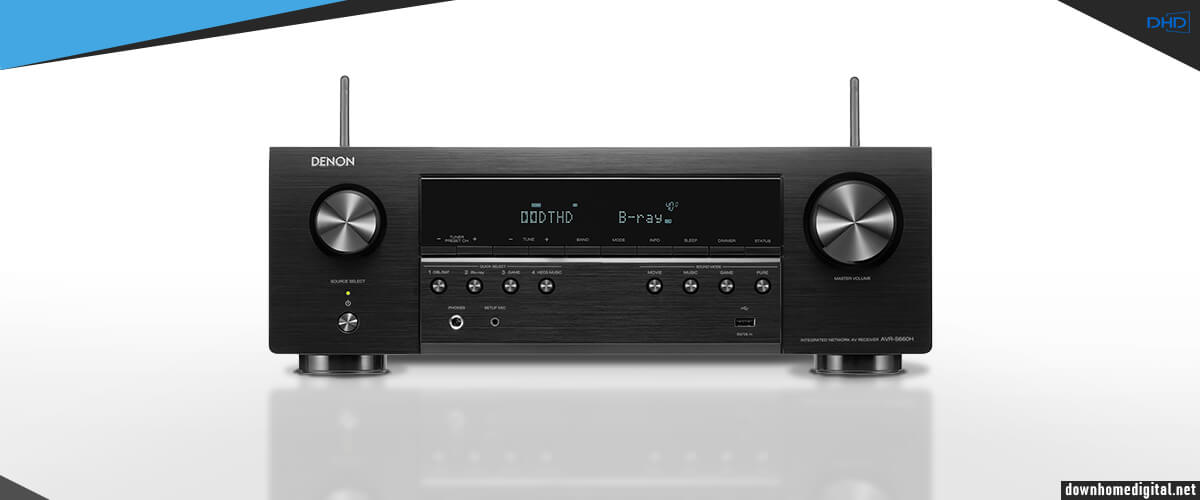
This model replaces the Denon 4K receiver S650H and already supports 8K over HDMI with 40 Gbps bandwidth. It operates with five amplification channels with 75 watts of power each. The three 8K HDMI inputs support all major HDR video formats: Dolby Vision, HDR10, HDR10+, Dynamic HDR, and HLG. The AVR-S660H has a total of six HDMI inputs – all of which also support HDCP 2.3. In addition, the novelty is equipped with the proprietary wireless technology Heos. With it, the receiver becomes an audio source for compatible wireless speakers like Denon Home 150, 250, and 350. I’ve categorized it as an entry-level receiver, and in my opinion, it optimally unlocks its full potential.
I would quite succeed if I wanted to describe the brand’s receivers in one fell swoop. All of them are similar; it can be called a Denon classic. AVR-S660H is no exception. Except that it has additional buttons below the LCD and on the panel below it. Which, for me, means I lap up both. However, I was surprised at how well the buttons were pressed (apparently, I deal with shoddy cases in other brands too often). The receiver is expected to be as light as a feather, so don’t let the household run around with the risk of dropping and crumpling the case.
Also, the support for Audyssey MultEQ Editor room calibration technology is another feature that differentiates this model from the previous one. In addition, its Dual Speaker Presets feature lets you switch between the two settings instantly.

The Denon AVR-S660H is equipped with Bluetooth and dual-band Wi-Fi for improved reception. The new AirPlay 2 protocol is supported, with which there is an iOS device-based wireless multi-room system. The AVR-S660H also works with Spotify, Pandora, and Tidal, plays Hi-Res audio PSM, and decodes DSD. Available formats include FLAC, ALAC, and WAV.
The receiver is compatible with Amazon Alexa, Google Assistant, and Apple Siri, so you can use voice commands to control the AVR-S660H and wireless music services.
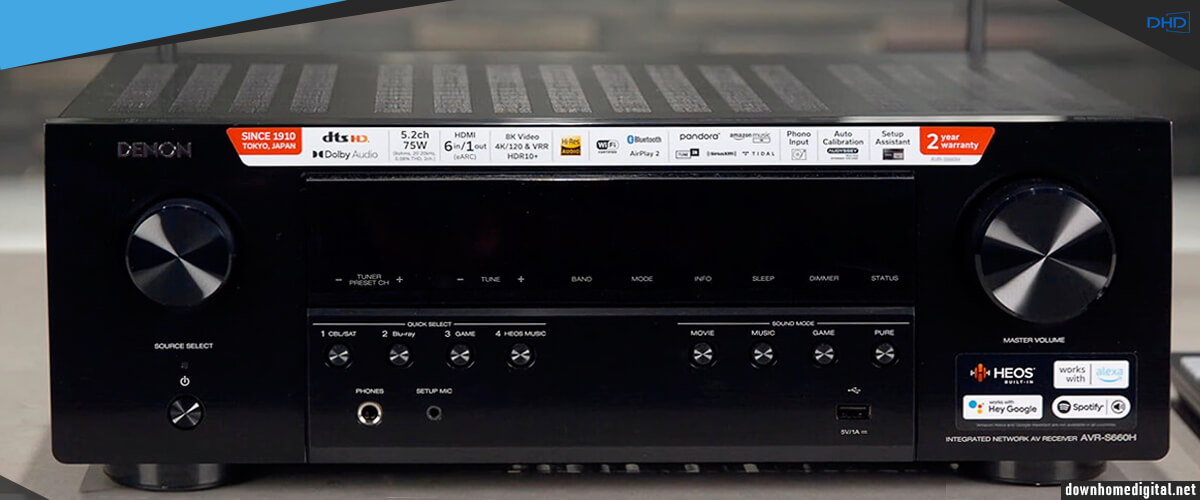
The sound of this model during testing was at a fairly high level. Separately, I was pleased with the dialogs, which took it to a new level. I assume that this was influenced by the Dialog Enhancer function to improve the dialogue sound.
Of course, the overall sound quality cannot be compared to the AVR-X3800H. But in general, it is not bad.
As a result, I can say that the AVR-S660H demonstrates excellent power and dynamics for an entry-level receiver. Even if it reproduces music rather mediocrely, it is in a home theater that you can fully unleash its potential with sound. Therefore, such a device is suitable for a small room. If you want to spend some evenings apart from your child, put the device in his room. You may not see your child for more than one evening. I can also see it in a workshop, study, guest room, or even on a small terrace. So, it could very well be used as an additional receiver in a larger home.
You’ll have to fiddle around with the settings to get good results from it, as its calibration system is pretty rudimentary, but is that worth considering when you’re facing an inexpensive purchase?
Nevertheless, if you’re looking for an AVR for a small apartment, I still recommend spending a little more and getting the Denon DRA-800H, which is capable of great things.
| Power |
|
| HDMI features |
|
| Video features |
|
| Network |
|
| Surround sound processing |
|
| Channels | 5.2 |
| Stereo power (RMS), W/Ohm | 75/8, 100/6 |
| Output impedance, Ohm | 8, 6 |
| Frequency response | 10Hz-100KHz |
| THD in stereo, % | 0.08 |
| Digital to analog converter (DAC) | AKM 192 KHz/32-bit |
| Bi-amping | no |
| Pure direct (straight) | yes |
| Auto speaker calibration | Audyssey MultEQ |
| Speaker A/B switching | no |
| Other audio features | Audyssey Dynamic Volume, Audyssey Dynamic EQ, Compressed Audio Restorer, Hi-Res audio |
| Wi-Fi | yes |
| USB | 1 (USB 2.0) |
| Bluetooth | yes |
| Ethernet (RJ45) | 1 |
| DLNA | no |
| MHL | no |
| Apple Music (AirPlay) | AirPlay, AirPlay 2 |
| Amazon Music | yes |
| Spotify | yes |
| Other streaming services | Deezer, TIDAL, Pandora, Napster, SiriusXM, TuneIn Radio, iHeart Radio, Sound Cloud, Mood Mix |
| HDMI input/output | 5/1 |
| HDMI ARC (Audio Return Channel) | yes |
| HDMI eARC (Enhanced Audio Return Channel) | yes |
| HDMI CEC | yes |
| Digital content protection (HDCP) | HDCP 2.3 |
| Subwoofer output (LFE) | 2 |
| Headphone output | 1 x 6.3 |
| Optical digital input | 2 |
| Coaxial digital input | 1 |
| Composite input | 2 |
| Component input/output | 0/0 |
| Phono (MM) input | yes |
| Front panel connectors | USB, phones, setup mic |
| Multi channel preamp output | no |
| HDR (High Dynamic Range) | HDR10 |
| 4K signal pass-through | 4K/60Hz |
| 8K signal pass-through | no |
| HDMI signal pass-through | yes |
| 3D signal pass-through | yes |
| HDMI pass-through in standby mode | yes |
| Video conversion | no |
| Analog to HDMI scaling | no |
| HDMI to HDMI scaling | no |
| Dolby Vision | yes |
| Other video features | HLG, BT.2020 |
| Voice control | Amazon Alexa, Google Assistant, Siri, Josh.AI |
| App control | iPhone, iPad, iPod, Android, Amazon Kindle |
| Display | colour OSD |
| Tuner | AM, FM |
| Sleep timer | yes |
| Auto power off | yes |
| ECO mode | yes |
| Graphical user interface (GUI) | yes |
| Setup assistant | yes |
| Firmware update | network, USB |
| Other additional features | IP Control, Web Control |
| Multi-room zones | has not |
| Zone audio output | has not |
| Zone HDMI output | has not |
| Multi-room control | has not |
| RS-232 | 0 |
| Remote control input/output (IR) | 0/0 |
| DC trigger output (12V) | 0 |
| Dolby Atmos | no |
| Dolby TrueHD | yes |
| Dolby Surround | no |
| Dolby (other) | Dolby Digital Plus |
| DTS:X | no |
| DTS HD Master | yes |
| DTS Virtual:X | no |
| DTS Neural:X | no |
| DTS (other) | DTS-ES, DTS 96/24, DTS-HD, DTS-EXPRESS |
| Auro-3D | no |
| IMAX Enhanced | no |
| Multichannel stereo | yes |
| MP3 | yes |
| WMA | yes |
| AAC | yes |
| WAV | yes |
| FLAC | yes |
| ALAC | yes |
| Other audio file formats | AIFF |
| Operational power consumption, W | 340 |
| Standby consumption, W | 0.1 |
| Removable power cord | yes |
| Size W x H x D, cm/inches | 43.5 x 15.2 x 33/17 x 6 x 13.3 |
| Weight, kg/lbs | 7.7/17.2 |
| Release year | 2019 |
Pros
- Advanced wireless connectivity options are available (limited compared to more expensive models).
- The number of HDMI ports is the same as the 7-channel Denon AVR-X1800H, with the same functionality.
- Dual Speaker Presets allows you to instantly switch between two settings.
Cons
- The smallest number of channels in the rating, 5.2.
- The smallest rating power is 75W.
- Sounds much simpler compared to the other models in the selection.
- The receiver setup process is unnecessarily complex.
Buyer’s guide
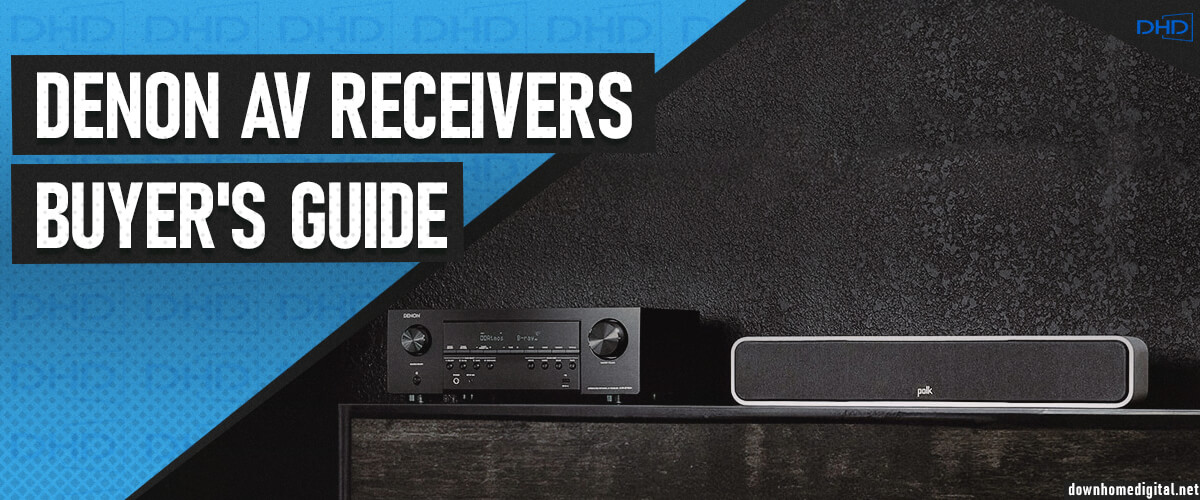
Key points to pay attention to when choosing a receiver
How many watts per channel do I need
The critical point for a home cinema receiver is the amplification power. In other words, it is the number of watts that are supplied to one channel. This is a delicate point that we must pay special attention to, as lack of power is one of the key factors that most affects the final perceived sound quality.
The amplification power that the receiver can supply to each channel is a significant point when choosing. Since it is the lack of energy that is one of the factors that most of all affects the resulting sound quality.
The power of a receiver must always be considered with the impedance at which it operates. For example, the Denon AVR-X8500HA has 150 W/channel at 8 Ohm or 190 W/channel per channel at 6 Ohm. This means it will work just fine with 8 ohms or 6 ohms impedance speakers. However, if you connect a loudspeaker with a higher impedance, the receiver will no longer have enough power, and you will get terrible noise.
The power given in the example will be quite enough for sounding large rooms (40 m3 and more). So, you need to look at the impedance of your speakers and the size of the room when choosing a receiver for power.
How many channels do I need?
When choosing a receiver, you should have a good understanding of where you are going to install the home theater system, in which room, what dimensions it has, the space available for placing speakers, etc.
On that basis, it will be easier for the user to determine how many channels need to use (usually 5.1 or 7.1). Currently, most mid to high-end receivers you find on the market are 7.1 or higher compatible, with 5.1 equipment falling into the budget bands. And you should understand that the more channels the receiver has, the more area it can sound.
And if you don’t have a budget issue, I recommend that you opt for at least 7.1 receivers because while you can’t help but use all channels right now, you will have these additional channels for future home theater upgrades.
Determine what you will connect to the receiver
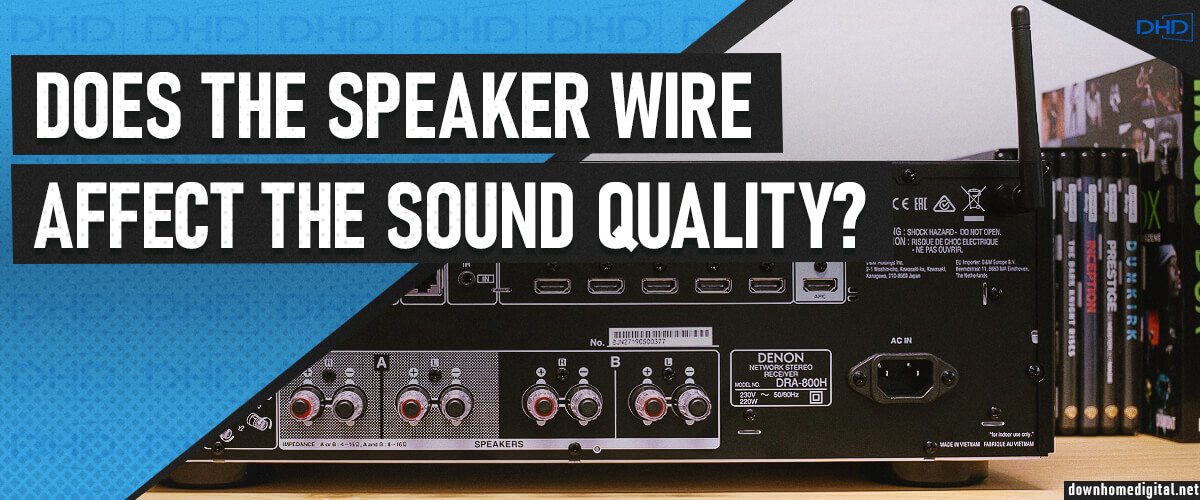
Communication with external devices makes a home media center out of the receiver. You need to study this direction carefully.
Wired
Speaker terminals and HDMI I/O are crucial for any receiver. The number of connectors for the connection of speakers depends directly on the power of the unit. The number of HDMI ports varies from model to model. You have to be careful and look at the version of these ports – HDMI 2.0 is now the most common and will allow you to transfer 4K content.
If you want to transmit signals digitally, then you should pay attention to the presence of optical and coaxial ports.
I also want to note that many new models still have analog RCA kits for connecting all kinds of equipment to the receiver. And this point will be especially important for vinyl lovers because the Pre Out outputs are just implemented through analog RCA.
Wireless
Also, do not forget about wireless technologies. In today’s reality, Wi-Fi and Bluetooth are absolutely essential. The first will enable us to use streaming services directly from the media device. The second will allow you to stream music from your mobile devices directly to the receiver.
Apple owners should pay attention to the presence of AirPlay or AirPlay 2. This is also used for streaming music.
And if you want to create a multi-room space, then you need features such as HEOS or Music Cast.
Extra features
There are some functions that are implemented in most receiver models.
4K, 8K
4K is now the generally accepted standard for high-definition video. Almost every model of modern receivers, from budget to expensive, has support for this format. The only difference is the refresh rate. 60Hz frequency is ubiquitous in models, but you can find 120Hz only in models with HDMI 2.1 support. However, the 8K format is only gaining popularity. This resolution has four times higher image clarity than 4K. And it needs high HDMI 2.1 bandwidth to run at 60Hz.
HDR and HDR 10+
The HDR technology dramatically expands both contrast and color! Bright areas of the picture can become much, much more colorful than on a regular TV, so the picture looks “deeper” and more realistic. The color palette expands with deeper shades of reds, greens, and blues – and all possible combinations.
Along with HDR came a new standard for the Rec. 2020, which contains such shades that it was simply impossible to reproduce them on an ordinary TV. However, Understanding the following – HDR video allows you to see the picture exactly as the manufacturer (film company) intended is crucial. Video with HDR should accurately reproduce the atmosphere planned by the author.
Dolby Atmos and DTS:X
Both technologies provide complete immersion in sound systems but achieve it in different ways.
Dolby Atmos does not allow the soundtrack to be captured channel by channel, but instead puts the sound objects in speakers in a room, as the sound engineer intended. The Dolby Atmos processor recreates the recorded surround sound picture in Real-time, depending on the number of speakers utilized in the system.
DTS X audio is an open-source audio format of the next generation. DTS: X can place sounds over the whole room, like its competitor Dolby Atmos, in contrast to traditional surround sounds technologies.
Multiroom
Multi-room features help listen to music or view a film in numerous rooms simultaneously. The simplest multi-room (for example, for a one-two-room apartment) you can organize on the basis of a multi-zone receiver that you decided to purchase for a home cinema system in the living room. In this case, the model of the receiver must be selected, taking into account the availability of exceptional audio, and for some models, video outputs to additional zones.
Moreover, there is an alternative. A multi-room system can be based on self-contained sound devices, consisting of several active components (speakers, amplifiers, switches) that can receive and distribute multiroom audio both in wired and wireless modes. Some models of receivers have support for one technology or another – HEOS, Sonos, Music Cast.

